#this was all about 70-90 years ago in world history
Text
No paywall version here.
"Two and a half years ago, when I was asked to help write the most authoritative report on climate change in the United States, I hesitated...
In the end, I said yes, but reluctantly. Frankly, I was sick of admonishing people about how bad things could get. Scientists have raised the alarm over and over again, and still the temperature rises. Extreme events like heat waves, floods and droughts are becoming more severe and frequent, exactly as we predicted they would. We were proved right. It didn’t seem to matter.
Our report, which was released on Tuesday, contains more dire warnings. There are plenty of new reasons for despair. Thanks to recent scientific advances, we can now link climate change to specific extreme weather disasters, and we have a better understanding of how the feedback loops in the climate system can make warming even worse. We can also now more confidently forecast catastrophic outcomes if global emissions continue on their current trajectory.
But to me, the most surprising new finding in the Fifth National Climate Assessment is this: There has been genuine progress, too.
I’m used to mind-boggling numbers, and there are many of them in this report. Human beings have put about 1.6 trillion tons of carbon in the atmosphere since the Industrial Revolution — more than the weight of every living thing on Earth combined. But as we wrote the report, I learned other, even more mind-boggling numbers. In the last decade, the cost of wind energy has declined by 70 percent and solar has declined 90 percent. Renewables now make up 80 percent of new electricity generation capacity. Our country’s greenhouse gas emissions are falling, even as our G.D.P. and population grow.
In the report, we were tasked with projecting future climate change. We showed what the United States would look like if the world warms by 2 degrees Celsius. It wasn’t a pretty picture: more heat waves, more uncomfortably hot nights, more downpours, more droughts. If greenhouse emissions continue to rise, we could reach that point in the next couple of decades. If they fall a little, maybe we can stave it off until the middle of the century. But our findings also offered a glimmer of hope: If emissions fall dramatically, as the report suggested they could, we may never reach 2 degrees Celsius at all.
For the first time in my career, I felt something strange: optimism.
And that simple realization was enough to convince me that releasing yet another climate report was worthwhile.
Something has changed in the United States, and not just the climate. State, local and tribal governments all around the country have begun to take action. Some politicians now actually campaign on climate change, instead of ignoring or lying about it. Congress passed federal climate legislation — something I’d long regarded as impossible — in 2022 as we turned in the first draft.
[Note: She's talking about the Inflation Reduction Act and the Infrastructure Act, which despite the names were the two biggest climate packages passed in US history. And their passage in mid 2022 was a big turning point: that's when, for the first time in decades, a lot of scientists started looking at the numbers - esp the ones that would come from the IRA's funding - and said "Wait, holy shit, we have an actual chance."]
And while the report stresses the urgency of limiting warming to prevent terrible risks, it has a new message, too: We can do this. We now know how to make the dramatic emissions cuts we’d need to limit warming, and it’s very possible to do this in a way that’s sustainable, healthy and fair.
The conversation has moved on, and the role of scientists has changed. We’re not just warning of danger anymore. We’re showing the way to safety.
I was wrong about those previous reports: They did matter, after all. While climate scientists were warning the world of disaster, a small army of scientists, engineers, policymakers and others were getting to work. These first responders have helped move us toward our climate goals. Our warnings did their job.
To limit global warming, we need many more people to get on board... We need to reach those who haven’t yet been moved by our warnings. I’m not talking about the fossil fuel industry here; nor do I particularly care about winning over the small but noisy group of committed climate deniers. But I believe we can reach the many people whose eyes glaze over when they hear yet another dire warning or see another report like the one we just published.
The reason is that now, we have a better story to tell. The evidence is clear: Responding to climate change will not only create a better world for our children and grandchildren, but it will also make the world better for us right now.
Eliminating the sources of greenhouse gas emissions will make our air and water cleaner, our economy stronger and our quality of life better. It could save hundreds of thousands or even millions of lives across the country through air quality benefits alone. Using land more wisely can both limit climate change and protect biodiversity. Climate change most strongly affects communities that get a raw deal in our society: people with low incomes, people of color, children and the elderly. And climate action can be an opportunity to redress legacies of racism, neglect and injustice.
I could still tell you scary stories about a future ravaged by climate change, and they’d be true, at least on the trajectory we’re currently on. But it’s also true that we have a once-in-human-history chance not only to prevent the worst effects but also to make the world better right now. It would be a shame to squander this opportunity. So I don’t just want to talk about the problems anymore. I want to talk about the solutions. Consider this your last warning from me."
-via New York Times. Opinion essay by leading climate scientist Kate Marvel. November 18, 2023.
#WE CAN DO THIS#I SO TRULY BELIEVE THAT WE CAN DO THIS#WE CAN SAVE OURSELVES AND THE WORLD ALONG WITH US#climate crisis#united states#climate change#conservation#hope posting#sustainability#climate news#climate action#climate emergency#fossil fuels#global warming#environmentalism#climate hope#solarpunk#climate optimism#climate policy#earth#science#climate science#meteorology#extreme weather#renewable energy#solar power#wind power#renewables#carbon emissions#climate justice
33K notes
·
View notes
Text
A Quick History of BL
As someone who wrote a thesis on this very subject a few years ago, here is the short version of how BL has evolved throughout the years. For the new comers ❤
a minute of silence for the original form of this post that tumblr decied to not save right after I saved it
I am going to go with a chronological approach. Unfortunately, I cannot put everything in one post so if there’s any questions about this or that aspect of the history of BL that you want to know and it’s not talked about here, you are welcome to ask me directly :)
Context and influences - Japan in the 60′s
Before the US forced Japan to open its borders to the outside world in the 1800s, homosexual practices were common place between budist monks, samurais and kabuki actors. During the Edo period (1600s to 1800s) there was a very rich amount of poetry, art, books (such as Nanshoku Okagami (The Great Mirror of Male Love) by Ihara Saikaku) and codes of conduct about how to have a good master/aprentice relationship, kinda like the greeks if you know what I mean. However, with the arrival of western influences, in order to become a more “civilized” country, it was all put in the closet.
Yet, in the 60′s Japan started to pick it up again through literature about young androginous beautiful boys (aka bishounen). On one hand, in 1961, the novel Koibitotachi no Mori (A Lover’s Forest) by Mari Mori was published. It tells the story of a young and beautiful 19 year old worker and a half french half japanese aristocrat, and their tragic romance. On the other hand, Taruho Inagaki wrote Shounen ai no Bigaku (The esthetics of boy-love), an essay on aesthetic eroticism (of which he wrote a lot of). All this was know as Tanbi (lit. aesthetic) literature. It generally refered to literature with implied homosexuality and homoeroticism such as works by Oscar Wilde, Jean Cocteau, etc. And of course, Mori and Inagaki.
In chinese tanbi is read as danmei (term used to refer to BL novels in china today, ie: The Untamed it’s all connected friends).
From the birth of Shonen Ai to Yaoi - 70′s to the late 80′s
Around the beginning of the 70′s, shoujo was being revolutionized by the Year 24 Group, a generation of women manga authors (mangaka) who started to explore new themes. Among them, their interest in tanbi gave birth to a new subgenre: Shounen ai.
Their most known manga were:
Kaze to Ki no Uta (The Ballad of the Wind and Trees) by Keiko Takemiya, and
Toma no Shinzo (The Heart of Thomas) by Moto Hagio
Their stories are characterized by having suffering eurpoean bishounen in boarding schools, living an idealized perfect love (meaning passionate) that, despite the tragic end of one of them, lives forever in the other.
As this genre starts getting popular, more and more fans of these stories start making their own self published manga, aka doujinshi, of the genre. It is around this time that the term Yaoi is coined. Meaning “YAma nashi, Ochi nashi, Imi nashi” (no climax, no fall, no meaning). Basically PWP fanfiction, for the most part. Doujinshis could be considered an equivalent of fanfiction in manga form. It is also here that the term Fujoshi (aka Rotten Girl, for liking rotten things) starts being used to refer to women readers of yaoi.
With this rise in popularity come the start of the commercialization of the genre. Which meant the publication of magazines dedicated solely to yaoi/shonen ai/BL. The most popular yaoi manga magazine at the time was June. The common trait of their stories being the therapeutic power of the love between the mains. The traumatized character would heal throught this newfound love.
Most of the stories at this time happened in the West (Europe or the States) as the exploration of these dark themes intertwined with homosexual romance and homoeroticism still feel safer to explore as a foreign concept. One example would be Banana Fish (1985).
Commercialization and Yaoi Ronso - 90′s
As more publishing houses pick the genre up, the term Boys Love is used to include every type of manga about homosexuality made for women.
The increasing amount of BL series sees a changes in its themes:
the start of the “gay for you” trope where one mantains their heterosexuality despite being in a homsexual relationship,
the uke/seme dynamic (mirroring hetero realtionships) also relating to physical appearence (one being more feminine, the other being more masculine),
the use of rape as an act love (sexual violence has always been present but here it becomes a staple),
anal sex as the only type of sex,
older and more masculine men start to appear
they now happen in Japan
Good examples of the presence of these themes in manga are Gravitation (1996) or Yatteranneeze (1995).
However in 1992, Masaki Sato (a gay activist/drag queen) wrote a letter in a small scale feminist magazine attacking yaoi and pointing out how it “represented a kind of misappropriation or distortion of gay life that impacted negatively upon Japanese gay men”. The female readers of yaoi responded, defending the genre as a means to escape gender roles and explore sexual themes that was never meant to represent the realities of gay men. This is know as the Yaoi Ronso (Yaoi Debates).
The debate ended with both sides understanding more of each other, with mangakas starting to include queer views in their works. It also started the academic reasearch of BL.
Yet, it is a debate that has been restarted more than once, as it is still relevant despite the evolution of the genre.
more on this on another post
Globalization and coining of BL - 2000′s
By the beginning of the 2000s BL is being sold all over the world (like all manga), and has become a stable industry. We could say it has finally become it’s own genre.
Some of the most well known manga series, to us (in the west), of the time are:
Junjou Romantica 2002
Koi Suru Boukun 2004
Love Pistols 2004
Haru wo Daiteita 1999
all of these have anime adaptations for the curious ones
We also start seeing short anime adaptations or special episodes of the most popular series, with questionable themes, such as: adoptive father x adoptive son (Papa to Kiss in the Dark 2005), father x son’s friend (Kirepapa 2008), etc...
However the themes remain more or less the same. Junjou Romantica’s love story starts with a non-con sex scene by the older one (masc, seme) to the younger one (more feminine, uke) addressed years later in the manga btw. Koi Suru Boukun’s love story is triggered by aphrodisiacs and rape. They’re still very present in the stories but slowly going away. A mangaka that represents this era could be Natsume Isaku (Candy Color Paradox 2010).
Change is slow in Japan. Even though the voices of LGBT+ people started to be taken into account in the genre it is not until later that we see it reflect in the mangas themselves. However, we can already see the start of this in Doukyusei (Classmates) (2006) by Asumiko Nakamura. Also Kinou Nani Tabeta? (2007) which is actually part of a more mature genre: Seinen.
It is my personal (subjective) theory that the BL of this era was the one that got popular outside of Japan, which is why we see lots of references to the themes, tropes and dynamics of this time in today’s BL series.
The LGBTzation of BL and the rise of webtoons - 2010′s to 2020′s
Slowly but surely LGBT characters and themes enter the scene of BL. Existing simultaneously with the previous tropes and themes, we start seeing a shift in these stories. We now see:
characters that identify as gay or some type of queer
discussions about homophobia
more mature themes about life and romance
At the same time as we get the usual love stories with the usual themes, a new trend starts to take over. And we get simultaneously, cute, sometimes questionable but light love stories:
Love Stage 2010
Ashita wa Docchi da! 2011
Kieta Hatsukoi 2019
More profound stories and darker or more complex themes:
Blue Sky Complex 2013
Saezuru Tori wa Habatakanai 2011 (mafias)
Given 2013 (suicide)
Hidamari ga Kikoeru 2013 (deafness)
And others that adress the queer experience in a more mature way (which might actually fall into the Seinen genre)
Itoshi no Nekokke 2010 (slice of life, queer characters)
Smells like Green Spirit 2011 (two ways to deal with a homphobic society)
Strange 2014 (relationships between men)
Shimanami Tasogare 2015 (an LGBT group helps a closeted gay)
Old Fashioned Cupcake 2019 (you know this one 😉)
Bokura no Micro na Shuumatsu 2020 (the end of the world)
As queer stories are explored, BL mangakas and mangakas from other genres start to consider more stories about queer people such as the Josei Genderless Danshi ni Aisaretemasu (My Androgynous Boyfriend) (2018) by Tamekou, or the Shoujo Goukon ni Itarra Onna ga Inakatta Hanashi (The story of when I went to a mixer and there were no women) (2021) by Nana Aokawa.
Still, we can see two realities live side by side. Doukyuusei gets adapted into an impactful animated movie in 2016, meanwhile Banana Fish gets an anime adaptation that keeps the homoeroticism but not the homosexuality.
For those who might be interested. Here are some of the authors that represent the first half of this era, where they start to include newer points of view:
Scarlet Beriko, HAYAKAWA Nojiko, KURAHASHI Tomo, OGERETSU Tanaka, Harada, KII Kanna (Stranger by the Sea), etc...
And authors that while keeping classical themes break the stereotypes in a subtle manner:
CTK, ZAKK, Jyanome, Cocomi, Hidebu Takahashi, SUZUMARU Minta, etc...
Mangakas also no longer stick to one genre only. They explore whichever of them they want, from BL to Seinen to others.
ie: Tamekou,
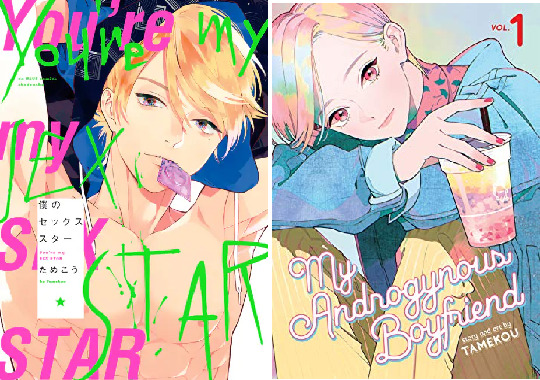
or Asumiko Nakamura

The curious case of Webtoons
With the digitalization of mangas, throught Renta and Lehzin, it has become easier (and more expensive) to access these stories. Korea makes and appearence with their webtoons. Through the lack of piracy protections and the majority of them being digital, manhwa (korean webtoons) sees a rise in popularity. Through the digital medium the influencee can be the influencer.
However, like many other East Asian countries they have consumed BL, without hearing about the conversations about BL. So they end up mantaining the older themes and stereotypes that newer BL is trying to leave behind. Therefore, we end up with a mix of old and new, ie:
Killing Stalking 2016
Cherry Blossoms After Winter 2017
Painter of The Night 2019
Additionally, it is also thanks to the easy access to internet that Omegaverse, with its higher dramatic stakes (that parallel hetero dynamics), enters the mangasphere in 2016. It has grown in popularity ever since.
With the Thai BL Boom of 2020, Japan rediscovers its own BL market and starts investing in it more. Which is why we get live action adaptations of BL manga that was popular years ago (Candy Color Paradox was a manga from 2010), the more recent ones (The End of the World With You) or new anime adaptations (Saezuru Tori wa Habatakanai in 2020).
more on this in my japanese live action BL post
What has it become now? is it BL? ML? or Seinen? Or is it all just gay manga?
It is clear that Shoujo manga (with BL, Josei and Seinen) is exploring queer themes such as gender and sexuality more and more. Japan is interested in this conversation, not only in manga (Genderless fashion). Which brings up the current question in BL studies: Does it make sense to keep these categories?
As a response to BL, ML (Male Love), which is made by gay men for gay men, started happening (around the 70s too). And Bara (gay manga porn) in response to Yaoi. However both gay men and women read BL and ML. We also see other themes being explored through BL, such as friendship (in BL Metamorphose), food (in Kinou Nani Tabeta), male relationships of all kinds (in Strange), and different queer views on life and its challenges (in Shimanami Tasogare). More and more what is LGBT and what is BL is merging, the line is blurred.
Conclusion
BL has been in my life for longer than it hasn't. It is through shoujo and BL that I have come to understand people and romance.
It is flawed, like everything else this life, but it's flourishing in many ways.
The genre feels old and new at the same time.
We can still find shounen ai/tanbi elements in more modern manga (All About J). Or the gay for you in a new light (Itoshi no Nekkoke). Or more educational manga on queer issues (My Brother’s Husband by Gengoroh Tagame). BL has around 50 years of existence but it is also being born anew in Thailand and Korea.
BL manga will continue to evolve in acordance to Japanese tastes, as it is still a local market. Hopefully the korean webtoons that get popular will be the more daring ones in their themes. Who knows where it will go from here? The only thing we know for sure is that it will continue to change. Isn't it exciting?
A post on the evolution of live action BL in Japan is coming, to complement this post. As well as a more detailed explanation of the Yaoi Debates and gay manga.
#history of bl#bl post series#I feel like I left too much stuff out#I hope it makes sense#honestly I would really recommend reading some of those manga#they're super interesting#soon it'll be 20 years since I started reading BL#my gosh#if theres anything anyone wants to know more about#I'd love to write more :)#yaoi manga#bl manga
714 notes
·
View notes
Note
https://youtu.be/-tqop31_bzk?si=r0AQimzbIyjOSS80
What's your opinion about this video analysis about Satti's song showing "the New Greece"?
I have already briefly mentioned this video in a post I made in Greek about Marina.
I found the video exceptionally perceptive, as rarely it is when it is a foreign, American in this case I believe, exploration of anything modern Greek. The YT channel is called “Overthinking It” and, no lie, some extra effort works wonders. He’s incredibly accurate for a man who hasn’t done research on Greek culture and society prior to his analysis of Marina Satti’s song and its reception. I was honestly impressed.
It might not be 100% correct but that doesn’t mean much, even some Greek articles in newspapers were not totally “there” in my opinion.
My biggest objection would be the title “Marina Satti is showing Eurovision the New Greece”, which is not so much a mistake on his part as even in Greece the terms we use are, say, Neo Hellenes instead of Modern Greeks, for example. But in truth Marina is not showing the “New Greece”. Marina was showing a facet of Greece people don’t know or care to know about. That’s totally different.
Whereas we say that foreigners only know about Zeus, the Parthenon, philosophy, that’s not entirely true. Several foreigners know Syrtaki, feta, souvlaki, bouzouki and enjoy those things more, and those are parts of “New Greece”. Some maybe conventionally perceived as such, even. But even those things are too few to represent accurately the “mosaic of Greece”, new or old or whatever.
In Marina’s words, that is. She said in an interview that she wanted to present a glimpse of the mosaic. She wasn’t trying to show a “New Greece”, as in an entirely new entity separated or opposite from an old one, but the Current Greece, as in the “how Greece is faring” as we speak, which interests very few and it is a little odd to have people nitpick even the slightest detail of your history millennia ago but the entire population could self combust into thin air right now and nobody would bat an eye. The American understands more of that in the video, it’s just the title that is slightly odd but it’s also attracting clicks.
I would also however like to comment on Greeks and Europeans’ short memory: Marina is not the first to try this. Many Greek entries were attempting to show more of the “mosaic”. But she is the first in the latest years, when the world has started caring about Eurovision beyond the borders of Europe. It is new to these people for sure.
The juice here is not that Marina tried something supposedly novel. Not at all. The juice here is in WHAT she chose to present. She chose the more heavy-duty Balkan and the more-heavy duty oriental and she mixed it with modern urban rap/ trap culture. This is what the problem was for these people. She is showing something that many Greeks try to reject. THAT is the issue. But she is right. This too is a part of the mosaic.
Greeks just care too much how they look to outsiders. They are constantly afraid that a part of their culture / art will not be appreciated and thus rewarded.
I believe we must be left to do our thing without any poisoning afterthoughts. Some things will definitely not translate well to the global audience. But who cares? Even that is better than sending something that is not true to yourself.
Look at other countries. They send joke entries all the time. We only sent SAGAPO (and even that wasn’t intentionally a joke entry) like 20 years ago and we still can’t recover from the shock. Now we wouldn’t take this lightly either. We just take ourselves TOO seriously.
But if we just do our thing with calmness and confidence and openness to a potential bad result, we will build our own following. I mean. Greece already has a considerable following in Eurovision. Its noughties legacy remains strong and people are rediscovering now the very underrated 70s and 90s. In fact, Greece might be the country that gets the most pressure by Eurofans to send something about Greek culture. I legitimately have never seen comments or nowhere near as many anyway of European people being disappointed at other countries’ entries as much as they are repeatedly at a Greek entry, because it doesn’t have a Greek sound or Greek lyrics. I think this pressure from the Europeans in combination with the mixed receptions once Greece complies has really confused the Greek delegation and the Greek artists.
It seems what the Greek delegation forgets is that it obviously doesn’t have to only be Greek in the lyrics or the instruments. It also has to be, you know, a good song lol
I do think we generally fail to communicate our music very accurately in this contest. I don’t know why. Maybe it’s what I said, we are too scared what others will think and try to “adjust” our music to make it either more Western European or more stereotypey Greek in the monolithic way foreigners view Greece. And hence even the mosaic attempt sometimes falls flat. But even with all those problems, I believe we have our own signature. I just want us to reinforce exactly that. Do it more, do it better and do it UNAPOLOGETICALLY. Zari is nowhere near the ideal attempt but it is an attempt nonetheless, a new start that thrives on the unapologetic part.
PS. So far the best example of the Greek mosaic attempt being successful was Alcohol is Free by Koza Mostra and Agathon Iakovidis in 2013 which finished 6th and it could have been higher if so many Europeans had not clutched their pearls at the notion that their kids watching would think alcohol is offered freely at the time 🤦♀️🤦♀️🤦♀️ Different times I suppose. Now everyone is fine that every other entry is basically a strip show 🙃
PS 2. In any case I think it is Marina’s success that Zari caused or, rather, bared the social phenomenon that it did and that even foreign YouTubers are trying to decipher and explain what happened.
#Greece#Eurovision#Marina Satti#zari#eurovision song contest#Eurovision 2024#esc 2024#Greek culture#Greek facts#anon#ask
15 notes
·
View notes
Text
🍐MY JOURNEY🍐



I wanted to share a little about my journey from being normal kid to how I got all interested in loa and void.
Random question guys have y'all ever as a kid thought about what other people are doing in different part of the world.
When I was a kid I used to be a very curious person I still am,but my curiosity as a child was on different level mind you I did NOT have any idea about this loa or any spiritual things but after learning about loa 3 years ago I used to consider this as an spiritual awakening idk if it really is
During my summer or winter break I would always miss my friends and used to think "If I don't see them they probably won't exist" or "Now that I am imagining them they probably exist". This was really random of me to think that but frr I used to believe that if don't look or think of a place or person they simply don't exist and as we know kids can easily believe their own imagination,I too is used too but of course our society had filled my head with limitations and for years with the so call law of (not) attraction,I filled my head with limitations even more and then when I got introduced to LOAssumption I was afraid that it will also be a waste of time but there was a little hope,that I WILL have my dream life I did not care about how long it will take because the only think I learned from LOAttraction was patiences💀.
After that I found about subliminal,reality shifting and quantum jumping through amino. Shifting took all my attention for sure,and as I learn more about shifting I learned about glitch in matrix and this made me wonder I probably shifted, because believe me or not, I think I HAVE shifted not one but multiple times as a child, because I find 90's movie super nostalgic,when I see movies based in 70s,80s,or pictures and paintings seems so dang nostalgic like all those things related to 17-19 century and 90s are so damn nostalgic to me,I once found myself getting emotional in the museum after seeing a painting just because it felt so good in a way it felt like I am from that century,it is another reason why I have interest in history and mythology and also believe in mermaids.
Also the amount of deja vu I get every time I read about Roman Empire, Ancient Greeks and European or any history of other countries I feel emotionally attached like I was there once is INSANE.
All this got me even more curious about myself,and I think loa is giving me all the answers slowly,I feel like an spiritual awakening to me.
#void state#manifest#affirmations#void#manifesting#manifestation#lucid dreaming#affirmation tapes#shifting#shift reality
25 notes
·
View notes
Text
[ AUTHOR COMMENTARY ]
Times Sq is the first "building" character I went with for Manhattan Speaks simply because there's so much you could do with the place and I feel like it has characterized itself well enough. Like most people probably know vaguely what it is and might have some impression of it even if they've never been. I dislike it fundementally (especially after Disneyfication in the 90s) but man I can't not admit that from a historical lense it really has grown on me as a place of interest.
I just think there's something so devastatingly visceral about it. It's changed hands several times, has been repainted over and over and over with the NYC land development equivalent of landlord white paint to hide all the flaws. It's a capitalism cash cow and a total waste of energy but no matter what they do it's so flawed... and everyone in the city knows it's flawed.
I think being a major place of interest for tourists and shopping and commute while being hated by the people who should care about you so much while having a notable (but controversial) past and only being cared about because of your worth in the advertising world would make anyone neurotic. You don't get to be flawed because its bad publicity but its still So incredibly obvious that the facade isn't as strong as its made out to be.
Like the prime example of how well this place lends itself to characterization imo is looking at One Times Sq (pictured below) through the years. Gorgeous intricate flagship building that was put in a cage and then increasingly hidden from the world through bright flashing screens.
The times I have been in the area and walked by this building Ive always had to take a moment to look through the cracks, anything to get a glimpse of what once was. It's insane to me on a narrative/symbolic level that you can still see what's underneath and compared to the flashing ads it looks bleak!



It literally took them decades to care about the inside of the building again, only very very recently have they decided to renovate it. AND EVEN THEN ITS BEING USED FOR MORE ADS.
Here's a pic I took a couple years ago of the One TSQ facade. I think one of the screens shut off really adds to my point but anyway you can see the rounded windows from the 70s peeking through!!

There's so much more I could say on this but all in all it just circles back to me going insane about the city's architectural history and how interesting I find it.
I highly recommend looking at stuff from TSQ in the seventies or looking into the project "Messages to the Public" by the Public Art Fund. It's fantastic and the gallery Im gonna link here has some great examples, many of which are still relevant to this day.
#objectum#might make a part 2 of this or do a series while i develop other characters#author commentary#no id
3 notes
·
View notes
Text
this is gonna sound absolutely insane but yknow when people are like “oh my life’s so hard cuz i’m obsessed with a really random minor side character with 1 second of screen time” but then you see what character they’re talking about and it’s like. prosciutto from jojos bizarre adventure . i wish these people could walk a mile in my fuckin clown shoes cuz you really have no clue how good you have it until you’ve been fighting demons in the trenches trying to hunt and gather even 1 singular sentence of content about the randomest nichest side character from a doctor who serial from almost 50 years ago that NOBODYYY cares about . and the actor who played him has only really done stage acting + voice acting + really low budget british sitcoms from the 70s-90s so you can’t even watch his filmography because there literally isn’t one . he’s 75 years old now and i could email him and he would probably reply. and the only real mentions of this character i love so so dearly are a page on the doctor who wiki and one inevitable throwaway line in every review of his episodes where they mention how flamboyantly homosexual he is and then they never mention him again . there will never be a poorly written x reader fic on tumblr or a MS paint deviantart drawing of him because i genuinely think only maybe 5 or 6 people have ever thought about him before in human history. and i’m one of them. and i’m going insane . there’s nothing out there . there’s literally nothing . there’s just oblivion. it’s just me and him and my beautiful mind and the world i weave around us that’s entirely my own creation and im absolutely enamoured with him to the point of madness but i can’t tell anyone about this because they’ll look at me like i’m smoking dick and balls from a crack pipe . anyway . how are we all doing tonight. i’m doing fine

2 notes
·
View notes
Text
By Bernie Sanders
Common Dreams
Sept. 2, 2024
The working people of our country are increasingly aware of the unprecedented level of corporate greed and power we are now experiencing, and the outrageous level of income and wealth inequality that exists.
As we celebrate Labor Day, 2024, there is some very good news.
Public approval of labor unions, at 70%, is higher today than it has been in decades. Over the last year major unions like the UAW have won some highly publicized strikes, while many other unions have negotiated trail-blazing contracts for their members. Young people at Starbucks and on college campuses are now more involved in labor organizing than ever before. And, for the first time in American history, a president of the United States, Joe Biden, walked a picket line with striking workers.
It is not an accident as to why we are now seeing more militancy and growth in the labor movement. The working people of our country are increasingly aware of the unprecedented level of corporate greed and power we are now experiencing, and the outrageous level of income and wealth inequality that exists. They understand that never before in American history have so few had so much, while so many continue to struggle. And they are fighting back. They know that workers in unions can negotiate contracts that give them better wages, working conditions and benefits than non-union workers. They appreciate that when you’re in a union you have some power against the arbitrary decisions corporate bosses.
On this Labor Day, let us redouble our efforts to grow trade unionism in America and create the kind of grassroots movement we need to take on the power of the Oligarchy.
Working people today are more than aware that, over the last 50 years, there has been a massive transfer of wealth from the bottom 90% to the top 1%. They are disgusted that, despite huge increases in worker productivity, real inflation-accounted for wages for the average American worker are lower now than they were over 50 years ago as 60% of Americans live paycheck to paycheck. They are insulted that CEOs of major corporations make almost 350 times as much as their average employee. They are concerned that the American dream is ending and that their kids may have an even lower standard of living than they do. And they worry that with the rapid growth of Artificial Intelligence and robotics, they have no power as to what will happen to their jobs as the economy undergoes major transformations.
The average American worker also understands that his/her political power has been significantly diminished as billionaires pour huge amounts of money into both political parties as they undermine our democracy. It is no great secret as to who now has the clout in Congress. It is the billionaires, the corporate CEOs, the campaign donors and their well-connected lobbyists.
Bottom line: The average American worker is sick and tired of status quo economics and politics. He/she knows that in the richest country on earth we can and should have an economy and political system that works for all, and not just the wealthy few, and that a strong union movement is the vehicle for bringing about the changes that we need.
On this Labor Day, as we reaffirm our support for the trade union movement and for labor solidarity throughout the world, as we continue to fight the day to day struggles against corporate greed, it’s important that we not lose sight of our vision for the future and what kind of country we want to become. Here, in my view, are just a few components of the agenda we need to fight for.
We must establish a vibrant democratic political system. One person, one vote. We must end the disastrous Citizens United Supreme Court decision and the billionaire funding of campaigns through super-PACs. We need to move to the public funding of elections and give political power back to ordinary Americans.
We need to pass the PRO Act and end the ability of companies to illegally intimidate and fire workers who want to join a union. Corporate interests spend an estimated $400 million a year on anti-union consultants who do everything possible, legal and illegal, to fight the right of workers to join unions.
We need to end starvation wages in America and raise the $7.25 an hour federal minimum wage to a living wage. People should not have to work two or three jobs just to pay the bills for their families.
We need trade policies that benefit workers in the U.S. and abroad, not just the CEOs and stockholders of major conglomerates. We need to rebuild our manufacturing sector and create good paying jobs here.
We need to join the rest of the industrialized world and guarantee health care to all people as a human right through a Medicare for All, single payer system. No one should go bankrupt because of a hospital stay. Everyone in America, regardless of income, should have the right to see a doctor.
We must finally guarantee paid family and medical leave to every worker in America. New moms and dads should be able to spend the first few months after delivery with their newborn child. Family members should be able to care for a loved-one who is sick without having to worry about missing a paycheck.
Like health care, education and job training must be considered a human right from childcare to graduate school. At a time when, in a highly competitive global economy, we need the best-educated workforce in the world, no one should be forced to go deeply in debt to get the education and training they need to be productive members of our society.
At a time when 50% of older workers have nothing in the bank for retirement, and 25% of seniors are trying to live on $15,000 a year or less, we must re-establish Defined Benefit Pension plans and increase Social Security benefits. Workers are entitled to a secure and dignified retirement.
And finally, we must address the unprecedented and outrageous level of income and wealth inequality that currently exists. No. It is not acceptable that three multibillionaires own more wealth than the bottom half of American society. It is not acceptable that many billionaires pay an effective tax rate that is lower than truck drivers or nurses. We need a progressive tax system that demands that the wealthiest people in our country finally start paying their fair share of taxes.
Let’s be clear. None of these progressive concepts are “radical.” While they are opposed by the Big Money interests and marginalized by the corporate media and the political establishment, they are strongly supported by a majority of the American people. Most of these ideas, in one form or another, are already in place in other wealthy countries around the world.
So, on this Labor Day, let us redouble our efforts to grow trade unionism in America and create the kind of grassroots movement we need to take on the power of the Oligarchy. Let us, in the wealthiest nation in the history of the world, create an economy that provides a decent standard of living for all, and not just massive and obscene income and wealth inequality.
1 note
·
View note
Text
January Comics Round Up
Decided to do this monthly for my own edification
Green Arrow! Read a few golden age that were in the 70 year history, then the brave and bold 85, then did 70s green lantern/green arrow (76-128), then read the backups in action comics (421-458) and worlds finest (244-286). I had already read the backups in detective comics a couple months ago so just went straight to the 1983 mini and then longbow hunters (which is 1988 and therefore my stopping point).
I really enjoyed the first half of the green lantern/ green arrow run. Road trip with unlikely companions my beloved. Also snowbirds don't fly was a wildly good story for its time. Love Ollie as the activist hero for the downtrodden. It's really amusing to me that in fandom the pervasive idea of him being rich like Bruce is everywhere, but he spent all of the 70s and 80s totally broke working class. Maybe he gets his cash back in the 90s? I dunno yet. I was honestly not really a fan of the dark and gritty turn that longbow hunters took, and honestly I'm super pissed about how dirty it did Dinah.
The 70s Jubilee! Issues were read in 2 year chunks so I could stay chronological without having to switch around too much.
Justice League of America (75-186) (1969-1980)
Started reading at 75 cause I wanted to do a Dinah read and that meant JLA (having just said last month that i was Definitely Not going to read Justice League, no sir, too many other comics to read) JLA does a good job as an ensemble comic, which can get pretty confusing and surface level? the more people you add. Coincidentally my least favorite issues were the yearly crossovers with Justice Society, and it got even worse when they added a third team in just for funsies. My surprise fave is Red Tornado can't get enough of that robot being like, I can never understand human love (is a more caring partner and parent than 90% of humans). Any way when I started this I realized that as Barry was a major character I should prolly coread it with the flash...
The Flash (105-305) (1959-1982)
So I'm not really a silver age fan (bronze age woo!), it's always been a bit of a slog for me, but I couldn't figure out a good starting issue in the 70s so I decided to let the completionist in me win and started from Barry's beginning. Love this guy very much! It is wierd the sort of difference of characterization for Barry between JLA and Flash? Like JLA often has Barry being a bit more conservative and stayed, especially in comparison to Ollie. Diana has beef with him when she comes back to the team and he gets accused of being chauvinistic more than once. None of that going on in Flash.
Kirby's Fourth World!
Forever People (1-11) (1971-1972)
New Gods (1-19)(1971-1972, 1977-1978) and the finale issues in Adventure Comics
Mister Miracle (1-25)(1971-1974, 1977-1978)
New Gods and Mister Miracle were So Much Better with Kirby at helm omg. I was very very charmed by the Forever People and I'm sad that it ended like it did, shunting them off to never? be seen again. Also, I never before knew what the anti-life equation was all about! It's been mentioned in other comics and other mediums but I always thought it was a kill all life sort of thing, but it being a blind obedience sort of thing is waaay better!
The Demon (1-12) (1972-1974)
More Kirby. Fun to meet OG Jason Blood and Klarion. It's set in Gotham and a lot of the time I was wondering 'where's Bruce in all this?' The funny answer is that if it has to do with magic, He Does Not See.
Supergirl (1-10) (1972-1974)
Cute! It was sort of fun to read a comic that was clearly aimed at girls for once, even if the 4 different authors (for only 10 issues!) are all men and all have different ideas of what is important to girls. The last issue was a very inexplicable crossover with Prez (they're not supposed to be set on the same earth???? i think???)
Prez (1973)
Gave it a try. Wild and wacky is a way to describe it.
Swamp Thing (1-24)(1972-1976)
Read this one in the trade volumes so it included all of his other appearances too. Loved it, love this guy, really love the sort of bleakness but there's always hope vibes too it.
*siighh* The Joker (1-10) (1975-1976)
2 things: ha ha hacienda, and the joker RV.
Man Bat (1977)
Only two issues and I liked Kirk's stories in Batman Family so I gave them a read. Not really worth it, didn't have what I liked about the fam stories (hero for hire/private detective who has control over himself)
Black Lightning (1-11) (1977-1978) plus the trade volume that collects all his other appearances up to the 90s (except outsiders)
I already read the Outsiders so this was more backstory to me but it was good! Jeff Pierce is great i love him! The JLA did him v. dirty and he was right not to join.
Firestorm (1-5) (1978)
Firestorm started showing up as the backup in Flash so I figured I'd go read the intro comic. Ronnie is the most high-school boy ever, and the fact that he's a jock getting bullied by a nerd gives me real big dog vs little dog energy. Also rip professor stein ur life is terrible.
Got through the 70s Jubilee in January!! But that reading list only had 13 entries! The 80s Bonanza has more than twice that many!
1 note
·
View note
Photo
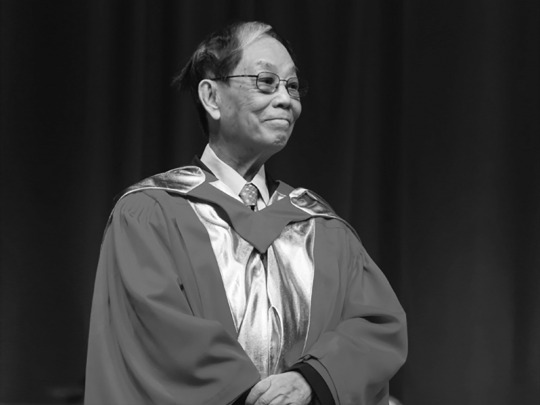

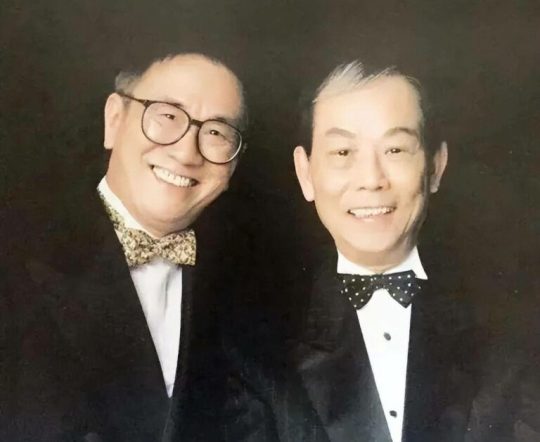
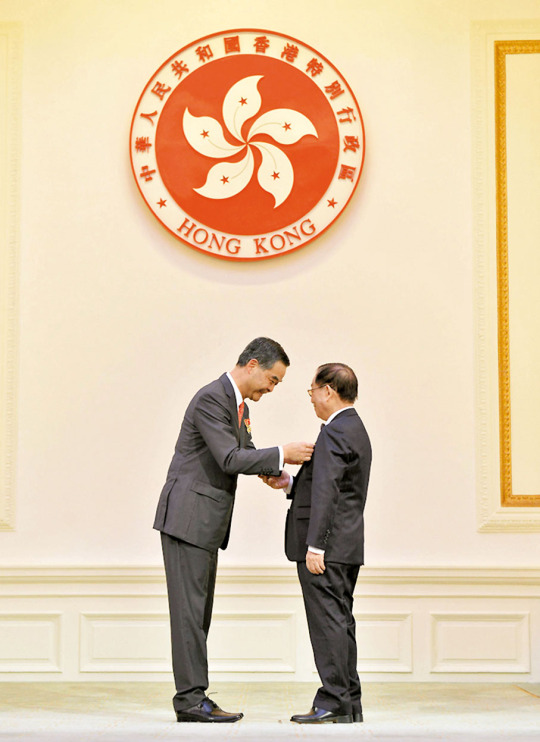
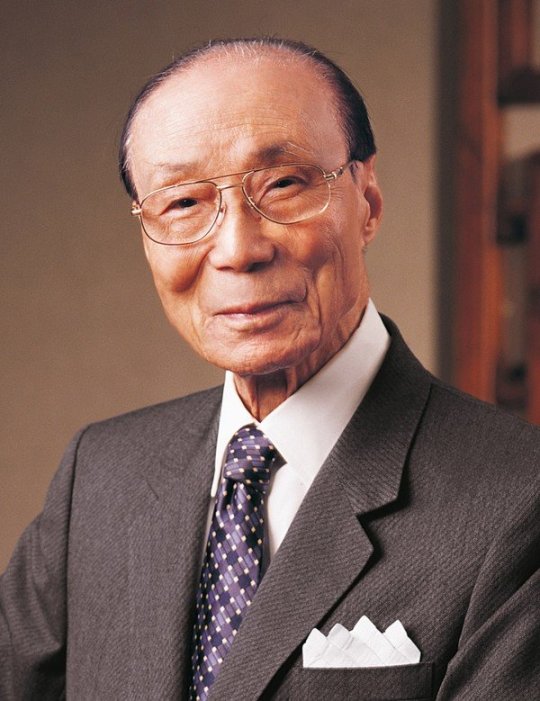

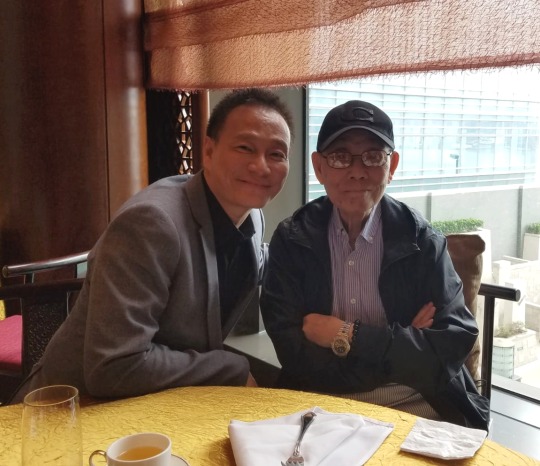

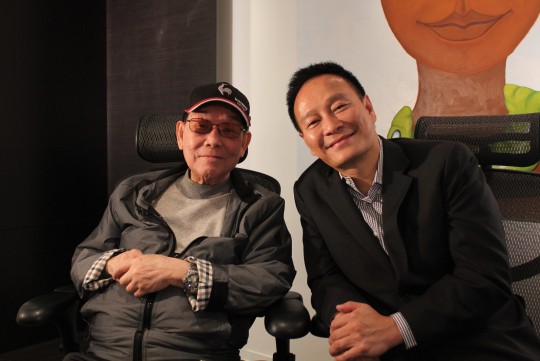
The Biggest Music Hero In The History Of Hong Kong, Master Joseph Koo Ka-fai—Our Quiet Friendship And The 2 Great Lessons Given by him
Music that has no past, neither has present…nor future.
The first phonograph record was released in Hong Kong in the 1930s. Cantonese opera ditties and folk songs were popular in those days. Honouring the old music masters of Hong Kong like heroes is the gesture that we can show for all the hard work and sacrifices which they did for our city in the past.
The greatest pop music master of Hong Kong Joseph Koo(顧嘉煇), born in 1931, passed away in Canada in 2023 at the ripe old age of 92. Blessed are those who mourn, for they shall be comforted. God will never abandon his family and friends, and shall provide them with love to take place of sorrow.
During Master Koo’s golden days, singers in Hong Kong could not afford to lose face without one and would bide their time to wait for a song written by him. He wrote more than 1,200 songs for the history of Hong Kong covering the time periods of 1960s, 70s, 80s, 90s and 2000s. His first published song is called ‘Dream’(夢) as the theme song for the movie Love Without End(不了情) in 1961. His music touches people of Hong Kong emotionally, straight from the heart. His powerful songs produce a kind of pleasure and satisfaction which we cannot do without. They have become the spiritual language in our city. His most popular song ‘Below the Lion Rock’(獅子山下), almost the city anthem of Hong Kong, is a homage that, generation after generation, will be preserved here.
The medal of Gold Bauhinia Star(GBS) was awarded by Hong Kong government in 2015 to Master Koo for his distinguished music contributions of a very high degree of merit to the community. My femtor who initiated the heart-warming efforts to procure such an honour for Master Koo upon his retirement has also vanished gracefully from the political scene of Hong Kong. Time and tide wait for no man. I feel grey too, in whatever meaning of the word.
Master Koo was much older than me. It was not contrived circumstances that brought us together. About 20 years ago, I met him accidentally in the backstage area of a concert presented by Hong Kong Philharmonic Orchestra in the 2000s. We chatted and had a lot of shared life experience. People of two widely different age groups thus started to reach out to each other. He had his circle of pop music friends and I mainly came across people in the legal and fine art sectors. Yet, true friends were those whom trust came by and conversations could bring out our shared fun and understanding. Master Koo and I were like spices and we added flavours to each other’s life, intersecting as much as interacting.
I told him how I became a lawyer despite my dream of being a writer. He told me why he chose music instead of painting as his career. I told him why I left TVB station as a part-time scriptwriter in the 1980s. He told me how he joined TVB as their Music Director after studying in the Berklee College of Music in the 1960s. I told him I would present a play pertinent to our classic Cantonese opera The Purple Harpin(紫釵記). He told me he was asked to write a book which would be a mixture of autobiography and his songs. But, he hesitated as he felt tired of taking up such a task.
Master Koo travelled regularly between Hong Kong and his second home in Vancouver. When he was in Hong Kong, I would invite him to have a cup of coffee in a quiet local City Garden Hotel in North Point—only 2 of us, since he and I lived in 2 drastically different social circles and we had no close friends in common to be invited. We talked about art, culture, life and Hong Kong—why quality music was in a decline and how people could get hold of their dreams in the midst of all of that social instability in which we were living. Master was taciturn but very ready to bounce ideas off me.
My regular talks with Master Koo remind me of a world famous book Tuesdays with Morrie, first published in 1997, except that ours is a happy but not sad story. In that book, Mitch Albom, the author, visited his former college professor Morrie Schwartz regularly and Morrie taught him the practice of forgiveness. Master Koo taught me in a slightly different way: not everything in life was within our control and not letting go would not change our fate. Giving ourselves more time to enjoy peace and self-pampering would be the true meaning of freedom of life: the freedom of lifestyle and the freedom of not meeting the irrelevant people, no matter good, bad or ugly. He practised what he preached. After announcing formally his retirement in 2015, he cut off a lot of social contacts and devoting more time to himself and family only was the most agreeable way of fulfilling the remaining days of his life. He painted a lot, mostly about the scenic beauty around him. He enjoyed internet surfing which, like music, would let him spread his wings and soar into the air of an artist’s imagination. He still made songs, not for any commercial reason but only pleasing his creative vitality. For Master Koo, sedentariness would mean happy humility after a superstar like him fading away.
I learnt 2 life lessons from Master Koo and they are invaluable and worth cherishing. He told me that it was important not to live life on purpose but live life by accident. Luck was just a matter of hard work meeting opportunity. During World War II, he got no proper education and was forced by circumstances to become a nightclub pianist. He never gave up. He tried to be the best nightclub musician and so when the provost of Berklee College of Music stayed in Hong Kong for a short while and spotted his talent, he was offered a scholarship to study music. He was poor with a family to support. Master Koo was fortunate to get the surprising generous monetary gift from the movie tycoon Sir Run Run Shaw(邵逸夫) through his senior singer friend Mona Fong(方逸華). He completed his music education in Boston and returned to Hong Kong to work as the Music Director of TVB, the biggest television station in Hong Kong. He thrived on overcoming obstacles and deadlines and finally became the most successful music composer in the history of Hong Kong. Master Koo warmly smiled, “When an opportunity arises to test yourself, try to imagine it is also good luck and you must pick a course which may mean improving your life, no matter how many hardships that you will endure!”
He also taught me that human beings were tiny and feeble. We could not resist the acts of God. He sighed, “People liked to compliment me on my ‘great’ achievements. I don’t feel the same. My life is just a chronicle of the social milieu and cultural circumstance of Hong Kong existent in the 1960s to 1980s. During those days, the majority of the population in Hong Kong, a small city, got chiefly TV as their entertainment and this was why so many people could be familiar with my songs written for TV drama. Now, Hong Kong is part of a much bigger country and Asia too. It is no longer easy for a small city to start trends and we have to follow trends. Music fads come and go and we, as pop musicians, could only identify what trends to listen to and what trends to stay away from. No music piece is timeless unless our work, despite the trend, also embraces our own unique style which is about how you carry yourself in order to stand out.”
There are too many inspiring stories told by Master Koo that I want to share. He told stories about himself inside his own soul. Beautifully, his stories inspire me partially what I am today as a writer. We all learn and build ourselves out of stories of others, especially stories from a great hero like Master Koo who is the epitome of taste, wisdom and etiquette.
Look up at the sky. I saw clouds. There was a cloud which must be Master Koo. I miss this charming old gentleman Master Joseph Koo very much—sitting in solitude now, I want to be reticent and still like Master. Busy life at a certain stage of life can be meaningless. Calm yourself, get to feel your inner voice and listen to the song that Master Koo loves very much—‘Heart will Brush Aside’ (忘盡心中情)…
Maurice Lee
Chinese Version 中文版: https://www.patreon.com/posts/ji-shou-wo-he-gu-79042995?utm_medium=clipboard_copy&utm_source=copyLink&utm_campaign=postshare_creator&utm_content=join_link
1st song composed by Master Joseph Koo: “Dream” https://youtu.be/jmxwrQdaLMA Acknowledgement-Andy G
Song “Take care, Tonight” composed by Master Wong Fook Ling https://youtu.be/lF_A-aXdoTU Acknowledgement-Alan Kayangan
Master Joseph Koo’s Interview https://youtu.be/1X1QEdXpmnM Acknowledgement-HKCO
Song composed by Master Joseph Koo: “Below the Lion Rock” https://youtu.be/kKWA3aOjsXg Acknowledgement-沿途有你2
TVB/TVBS News Music by Master Joseph Koo https://youtu.be/S5wyNnVqbvs Acknowledgement-1912dzsnt
Song “Interlude” https://youtu.be/7qXej8xJeLk Acknowledgement-jpeglariosa
#Sir Run Run Shaw邵逸夫#Mona Fong方逸華#Mitch Albom#Morrie Schwartz#Gold Bauhinia Star#City Garden Hotel#Tuesdays With Morrie#Below The Lion Rock獅子山下#The Purple Harpin紫釵記#Heart Will Brush Aside忘盡心中情#Berklee College of Music#Hong Kong Philharmonic Orchestra
1 note
·
View note
Text
The second episode of The Falcon and the Winter Soldier showed Bucky's white privilege, and I hope people acknowledge rather than ignore it just because it’s uncomfortable. I’ve already seen people do that or worse as mentioned in my previous post.
Bucky is a great example that it’s not only evil people or people we dislike but also good people—people we count as allies or even friends—who benefit from whiteness. I would rather have that instead of some sanitized “woke ally” Bucky who can never do wrong. Bucky is human and like everyone else, he has room to learn and grow. That's better than insisting he would be woke about everything.
Just by existing, both Sam and Bucky are affected by systemic racism. Sam is oppressed and Bucky benefits, however passively or actively. We see that play out in several ways with Bucky this episode because he:
doesn't understand the situation with the cops and even though you can talk about the way that Bucky is treated by the government and law enforcement, you can't ignore how the cops gently guide him into the car and treat him with respect, apologizing, calling him "Mr. Barnes," and showing how reluctant they are to take him in
berates Sam for Sam's decision to give up the shield when, as Sam says, he has no right to tell Sam what he should do and neither Bucky nor Steve would understand
doesn't, in fact, get Sam's decision and makes the situation about Steve and himself. Is it understandable that he does? Yes. Does it change the fact that he makes it about himself rather than think about Sam's position? No
totally misreads how Sam would feel about seeing Isaiah or how it would affect Isaiah to talk about his trauma
most likely didn't consider the possibility that Isaiah is a victim of the government, not just a man affected by war or his time as a supersoldier
got therapy and a nice enough apartment unlike Isaiah who didn't get any help or any apology or redress for the wrongs committed against him: being experimented on, imprisoned for three decades, and exploited and harmed by both the U.S. government and Hydra throughout those years
Bucky wasn't intentionally being ignorant or trying to hurt anyone, but it doesn't matter. It's because of his white privilege that he's afforded better treatment than Sam and Isaiah. It's because of his white privilege that he has never had to think about what it's like to be them. He doesn't read the situation with the cops properly, and if his and Sam's situations were reversed, Sam most likely would have been assaulted or shot and killed at worst or roughly manhandled at best. He wrongly assumed that it wouldn’t bother Sam to meet Isaiah or thought it would only make him uncomfortable, probably no more uncomfortable than Bucky was about Isaiah’s situation. (Why he thinks talking to Isaiah will help, I don’t understand. It's not like Isaiah would have information about supersoldiers that Bucky, a supersoldier himself, wouldn't or information about the Flag Smashers. That group appeared recently. The Korean War was 70–73 years ago, and most likely Isaiah got out of prison in the ‘80s or ‘90s, depending on how long he was active after the war, decades before 2023.)
It all backfires because Bucky didn't know what happened to Isaiah. He vaguely knew that Isaiah had a rough time but didn't know the details; you can tell he didn’t by how he reacts to Isaiah's story. He didn't think of asking Isaiah how he got his powers and what happened to him after the war before showing up at his house.
Bucky made huge assumptions that ended up hurting Isaiah and Sam, good intentions or not, and in my opinion, that naïveté and ignorance stem from white privilege. He probably assumed that Isaiah volunteered to get the serum and it worked out because Isaiah was a good person and the U.S. were the "good guys" in the war. They weren't Hydra, and Isaiah was a U.S. soldier who fought against him when he was the Winter Soldier. It never crossed his mind that Isaiah's situation could have been drastically different from Steve's situation and that the U.S. government could have abused and abandoned a hero like Isaiah so badly.
Although this is a big extrapolation on my part, I don't think it's that much of a stretch to say. Had Bucky thought this was the case, I find it extremely unlikely that he would have brought Sam there or wanted to bother Isaiah, at least without advance warning. If anything, as @fahbee mentioned in their reblog of the original, unedited version of this post, he might have looked at the gap in Isaiah’s life when he was in prison and assumed that Hydra or some other evil entity had captured and held Isaiah as a POW during that time. That is, if there was a gap; that’s plausible, but it’s also plausible that Isaiah was imprisoned under false charges and those charges appear on his record. The government has done that and still does that to many black people in real life. Either way, Bucky never would have thought that the U.S. government was responsible for Isaiah’s suffering.
Meanwhile, even though Sam is shaken to discover that a black supersoldier existed decades ago, I don't think he finds what happened to Isaiah surprising. Consider his reaction to Bucky’s when Isaiah tells them what happened and the fact that the U.S. has a history of experimenting on, exploiting, and abusing black men. Sam sees what the U.S. government did to a black man they experimented on and used, and he's broken over Isaiah...and for himself.
Isaiah is the living embodiment of Sam's conflicted feelings about the U.S. and the Captain America title. Who's to say that that won't be Sam too when they don't want or need him anymore? How can Sam be the symbol of a country who has harmed and continues to harm people like him? There's so much grief, pain, and anger there versus Bucky's cluelessness. Even after their meeting with Isaiah when he and Sam are in the therapy session together, Bucky doesn't connect the dots or understand Sam's feelings and inner turmoil at all.
As I said, I love how they included Bucky's white privilege because sometimes, it's not always as obvious as a white banker refusing to give a black family a loan or cops treating an innocent black man as a threat and escalating the situation (though sadly, some people have managed to miss even these overt examples of racism). Sometimes it's what I said above. I would rather see Bucky learn and grapple with racism and white privilege than see performative wokeness or an innate, intuitive understanding of racism in all its forms.
How Bucky moves in the world is different from how Sam does, and it serves as another way to demonstrate how Sam is very much black in this universe. That's why you can't ignore, minimize, or attempt to change (do NOT give me what-if scenarios about Bucky being a white ally) Bucky's actions and thoughts as well as how the world treats him because The Falcon and the Winter Soldier is very much a series about what it means to be black in America and what it means for Sam, a black man, to become Captain America.
1K notes
·
View notes
Note
Growing up in a socially progressive environment: How has this affected your feelings about success? Were you taught that forming a nuclear family played a role in that measurement? Or were you taught to value yourself strictly in terms of stuff like grades and academic achievements? Or maybe that whole talk was geared towards personal happiness, in whatever form it took for you?
Also, at school: did you have to do stuff like the pledge of allegiance? Was Columbus Day and history class transparent or did your teachers omit the fucked up parts?
--
The closest my mother ever came to advice about a nuclear family was: "Find a boyfriend after college. Roommates are awful."
(Though from what she said, this belief stemmed from being the one clueless white girl in an apartment with three black girls becoming politically conscious in 1970s Chicago. I'm pretty sure Mom was the annoying roommate in that scenario, so...)
She really didn't discuss success. I never asked, but I assume that this was a conscious choice the same as she never once mentioned my looks either positively or negatively. (I asked her about the latter, and she said it's something she'd decided on before having me.)
I've spent the last couple of years carting hundreds of pounds of books out of the house. Among them was a massive collection of child development books from the 70s through 90s. A lot of them were on topics like raising intellectuals rather than just kids who get good grades or fostering a sense of self worth and emotional self sufficiency.
My mom was an educator, and she disliked a lot of the status-obsessed ways people deform their children's senses of self. Grades = worth is not a message she'd ever have espoused, though she did send me to hard schools and expect me to do my work. She could be a school snob as much as anyone, but she didn't explicitly talk about success in those terms. I think a big part of it is that all of her friends from when she was young were intellectuals who wanted to be professors, found there were no jobs, and ended up as carpenters or in the Peace Corps or all kinds of other random things. My mother herself started a PhD in... epidemiology...? (Something sciencey anyway.) She bombed out when her much older sister died unexpectedly and ran off to Kathmandu to hang out with an old high school friend who was studying Tibetan Buddhist religious logic.
She was certainly concerned with me finding meaningful work and being self sufficient, but she just didn't talk in terms of "success".
And more than that, worth as a human is inherent. It has nothing to do with success. If you want to raise a strong person, you give a kid unconditional love, clear boundaries, and a sense of stability. You teach them that all humans are valid and worthwhile just because. They don't have to do anything to gain that. It just is.
Perhaps that's not how you meant "success", but I've seen far too many otherwise intelligent parents mutilate their children's ability to learn by treating education and knowledge as the source of value in the world and not as something pleasurable in their own right.
Perhaps happiness = success is closest to what my mother would have espoused, but really, being a valid human being is a separate axis from being happy or successful or any other particular measure of a life well lived.
--
None of my schools would have been caught dead making us say the pledge of allegiance. They were all hippie private schools. We did shit like learn to sing This Land is Your Land.
We spent a lot of time on Indigenous history—though still in a "That was long ago" kind of way that made me assume everyone was dead and gone. Genocide was mentioned often. Columbus was mentioned rarely, and not in positive terms.
I still wouldn't say it was particularly well-rounded history. I'd rather have learned more about the Mexican-American war and less about the utterly irrelevant snoozeville that is the American Revolutionary War. Frankly, as a Californian, I would reduce the Revolutionary war to "It happened" and our equally boring Civil War to the politically important parts that it was indeed fought over slavery as Southerners themselves said at the time, that all that noble lost cause shit is just a retcon by white supremacists, and anybody who repeats it in the modern day can fuck themselves.
We did have pretty good stuff on Harriet Tubman in second grade and lots on Japanese internment later. Some of the schools I went to were better than others, usually because they were less beholden to stuffing our heads with irrelevant garbage that's on major history tests. I could have done with slightly fewer traumatizing documentaries on the Holocaust though.
--
As for my personal feelings about success, towards the end of my 30s, I was looking around for what should come next. I decided to finally write a novel, and I feel a lot better about my 40s having done so. I wasn't desperate or self hating like a lot of people I see around me fearing aging, but I did feel a lack of accomplishment in a sense.
My next goal... well, my immediate next goal is to finish book 2 of my series, but in the longer term, my goal is to not just finish writing things but to become financially successful as a writer.
50 notes
·
View notes
Text
does anyone feel like truly "iconic" and timeless things aren't being made anymore?? like we still listen to music from the 70s and that's 50 whole years ago but personally I can't see any of the stuff that's on the radio right now being played/remembered in 5 years from now, let alone 50!! and I feel like the last few songs that will be remembered were made in the late 90s/early 2000s. and same for movies as well! and I'm not talking strictly about critically acclaimed stuff but also just things that everyone knows and remembers like the Christmas classics! those are all at least 10 years old and I'm like?? isn't that weird?? also all the stuff that became kind of iconic despite not being very good but we still all love and remember it because of the nostalgia like Twilight! or high school musical! or all the iconic pop songs ! like those are all things that a whole generation of people grew up with and still remembers fondly. and maybe I'm just not paying attention but I feel like there's nothing like that being made anymore you know? like in 10/20 years will anyone still remember/listen to/watch things from these years? is there anything that connects everyone (apart from the world dying)? and I could say the same about fashion too!! think about the fashion in history! even just taking the last century, the 50s/60s/70s/80s/90s (and in their own ways also the horrible fashion trends of the early 00s that we love to look back to!)those eras are so iconic and distinguishable that we can recognize the dates of photos just by the clothes! and we love them so much we even have parties/events that have those eras as themes! but the fashion that's been around now and for the last like 5 years?? there's literally nothing that will make it distinguishable or unique/iconic imo and half of it is just recycling trends from those past eras bc we have no more ideas apparently!! can u even imagine a 2020s fashion themed party in the future?? just a bunch of ppl dressed like the Kardashians??! no!!!! why is this happening!!! also the songs/movies/fashion etc themselves seem to be made with the awareness that they won't last long! it's all just for getting as much success as soon as possible before putting out the next thing! and it's all feeding the cycle ! idk where I'm going with this I guess my question is just... how did this happen!!???
230 notes
·
View notes
Text
Bessemer and the Power Shift
The most dramatic change in American capitalism over the last half century has been the emergence of corporate behemoths like Amazon and the simultaneous shrinkage of organized labor. The resulting imbalance has spawned near-record inequalities of income and wealth, corruption of democracy by big money, and the abandonment of the working class.
All this is coming to a head in several ways.
Next week, Amazon faces a union vote at its warehouse in Bessemer, Alabama. If successful, it would be Amazon's first U.S.-based union in its nearly 27-year history.
Conditions in Amazon’s warehouses would please Kim Jong un – strict production quotas, 10-hour workdays with only two half-hour breaks, unsafe procedures, arbitrary firings, “and they track our every move,” Jennifer Bates, a warehouse worker at Bessemer, told the Senate Budget Committee last week.
To thwart the union drive, Amazon has required Bessemer workers to attend anti-union meetings, warned workers they’d have to pay union dues (wrong – Alabama is a so-called “right-to-work” state that bars mandatory dues), and intimidated and harassed organizers.
Why is Amazon abusing its workers?
The company isn’t exactly hard-up. It’s the most profitable firm in America. Its executive chairman and largest shareholder, Jeff Bezos, is the richest man in the world, holding more wealth than the bottom 39 percent of Americans put together.
Amazon is abusing workers because it can.
Fifty years ago, General Motors was the largest employer in America. The typical GM worker earned $35 an hour in today's dollars and had a major say over working conditions. Today’s largest employers are Amazon and Walmart, each paying around $15 an hour and treating their workers like cattle.
The typical GM worker wasn’t "worth" more than twice today’s Amazon or Walmart worker and didn’t have more valuable insights about how work should be organized. The difference is GM workers a half-century ago had a strong union behind them, summoning the collective bargaining power of over a third of the entire American workforce.
By contrast, today's Amazon and Walmart workers are on their own. And because only 6.4 percent of America’s private-sector workers are now unionized, there’s little collective pressure on Amazon or Walmart to treat their workers any better.
Fifty years ago, “big labor” had enough political clout to ensure labor laws were enforced and that the government pushed giant firms like GM to sustain the middle class.
Today, organized labor’s political clout is miniscule by comparison. The biggest political players are giant corporations like Amazon. And what have they done with their muscle? Encouraged state “right-to-work” laws, diluted federal labor protections, and kept the National Labor Relations Board understaffed and overburdened.
They’ve also impelled government to lower their taxes (Amazon paid zero federal taxes in 2018); extorted states to provide them tax breaks as condition for locating facilities there (Amazon is a champion at this game); bullied cities where they’re headquartered (Amazon forced Seattle to back down on a plan to tax big corporations like itself to pay for homeless shelters); and wangled trade treaties allowing them to outsource so many jobs that blue-collar workers in America have little choice but to take low-paying, high-stress warehouse and delivery gigs.
Oh, and they’ve neutered antitrust laws, which in earlier era would have had companies like Amazon in their crosshairs.
This decades-long power shift – the emergence of corporate leviathans and the demise of labor unions – has resulted in a massive upward redistribution of income and wealth. The richest 0.1 of Americans now has almost as much wealth as the bottom 90 percent put together.
Corporate profits account for a growing share of the total economy and wages a declining share, with multi-billionaire executives and investors like Bezos taking home the lion’s share.
The power shift can be reversed -- but only with stronger labor laws, tougher trade deals, and a renewed commitment to antitrust.
The Biden administration and congressional Democrats appear willing. The House has just passed the toughest labor law reforms in over a generation. Biden’s new trade representative, Katherine Tai, promises that trade deals will protect the interests of American workers rather than exporters. And Biden is putting trustbusters in critical positions at the Federal Trade Commission and in the White House.
I’d like to think America is at a tipping point similar to where it was some hundred twenty years ago when the ravages and excesses of the Gilded Age precipitated what became known as the Progressive Era. Then, reformers reversed the course of American capitalism for the next 70 years, making it work for the many rather than the few.
Today’s progressive activists -- in Washington, at Amazon’s Bessemer warehouse, and elsewhere around the nation -- may be on the verge of doing the same.
547 notes
·
View notes
Text
My reasons to ship Erehisu
About two weeks ago, I got an anonymous ask that reads:
what made you ship erehisu? I don't ship anyone in the series (and defo not eremika lol) and I want to understand the reasons
...but when I tried to answer it on my app, it turned out that I can only post 10 pictures per post, so I decided to make a longer, regular one with my thoughts on this topic 😄 Erehisu remains one of my favorite ships in the series (...with the other ones being Yumi/hisu and Levi/han), so I really enjoy talking about it (...well, at least I did, before I started moving away from the series after that mess of a finale). Without further ado, my reasons to ship Erehisu are under the cut (just a quick warning: the pictures are obviously not mine, and there are some anti-eremika themes in this post).

They had an actual developement
As we know: in the beginning, Historia was pretending to be this good, selfless girl Krista. Later on, we learn that Eren was not particularly fond of her façade (...keep in mind he was the only person who noticed that she was acting off, too - obviously excluding Ymir, who was Historia's closest person and knew about her secret). As Historia chooses to embrace her identity and stop pretending, his opinion on her changes - he reassures her and appreciates the real Historia.


You’re just normal. Just a normal girl who’s absurdly honest. (Eren, ch. 54)
Eren...that day...the time you called me...normal. That made me really...happy. (Historia, ch. 65)
Later on, after Historia saves Eren in the Reiss cave, his thoughts on her change even further. There isn't just something that he likes about her anymore - instead, he starts to actually admire her strength and actions.

(ch. 68)

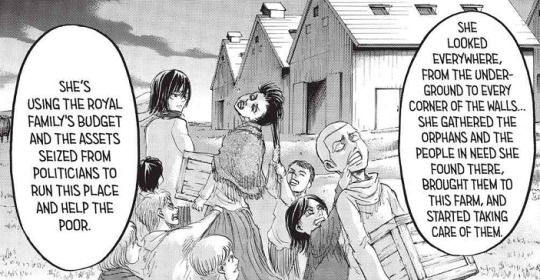
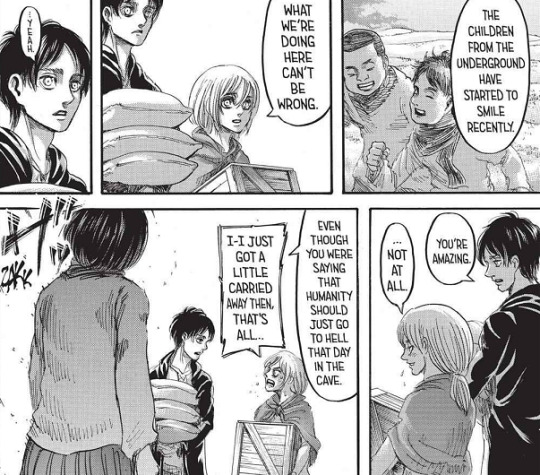
(ch. 70)
Even further on, he prioritizes her safety and hides an important piece of information that could help Paradis' cause - only because it could potentially put Historia in harm's way.
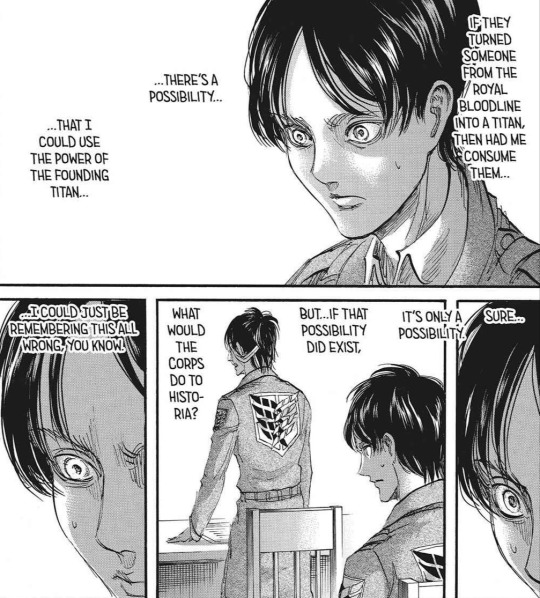
(ch. 89)
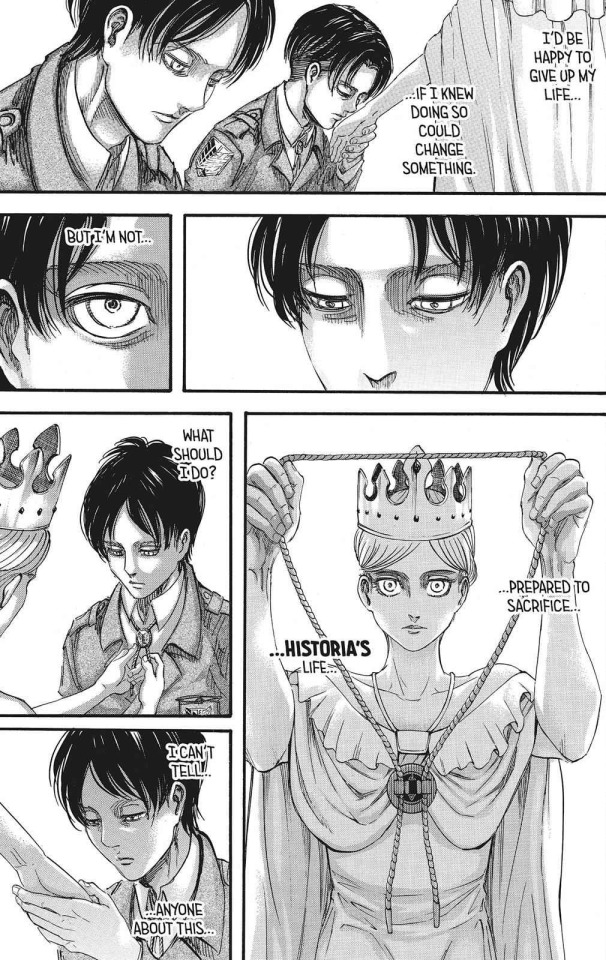
(ch. 90)

(ch. 106)
Keep in mind that there was a time skip in between these chapters, which means Eren kept this secret for years. He hid it even from Armin and Mikasa. After it's finally revealed, he strongly disagrees with, and fights against Historia becoming a titan for the sake of the island. Eren’s sentiment towards Historia is even noticed by Hanji on a few different occasions - it’s something that Hanji brings up while questioning him, later on.
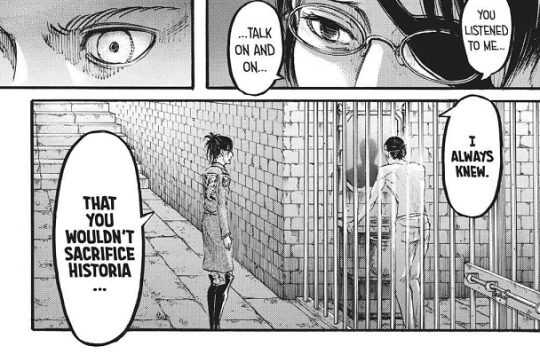
(ch. 107)
Eren also meets Historia in secret, warns her of danger, and downright doesn't let her sacrifice herself - even when she assures him that she's ready to do it.

(ch. 130)
She's also one of the only people with whom he shares the information about the rumbling. He also brings up her own words that she said to him back in the Reiss cave.
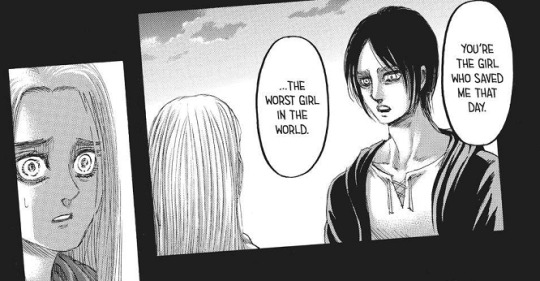
(ch. 130)
I believe he doesn't fight for her just because she's one of his friends. It's a natural progression that comes from the shared experience they had in the Reiss cave. Eren got to know and appreciate the real Historia, so whenever she reverts back to the Krista persona, he's there to remind her that she should live for herself and don't let others use her - just like Ymir told her, and just like Historia told him in the Reiss cave. When Eren stands up for Historia in ch. 107 and blatantly refuses to let her get sacrificed, she's actually touched to the point of tearing up.
Their relationship changes and deepens with time, and it's actually shown in the manga - not just as symbols or small hints, but actual, full-fledged conversations/actions. In my opinion, this should be the base of any well-estabilished ship. We have quite a few one-on-one moments with these two that illustrate this progression. There are also panels in which we can peak into Eren's thoughts on Historia, which makes for an unfiltered source of his opinions on her.
They can relate to each other
Something I find really important as well is that Eren and Historia can find each other very relatable, and therefore - understand each other's struggles better.
Both were used by their fathers, and both caused their demise. Both were fiercely protected by someone. Both felt like the world would be better without them, at some point. Both had a big role to play, despite having doubts if they can do it right (Eren, being humanity's titan; Historia, being the queen). Both wanted to sacrifice themselves for their people's sake - and both intervened, saving each other from actually going through with this decision.
Their relationship is well-balanced
Eren and Historia don't clash when it comes to their personalities. As their relationship grows, they mutually admire, protect and motivate each other, while still remaining two separate characters - with their own goals and traits. They freely talk to each other about their struggles; they also care about each other’s actual feelings on them.
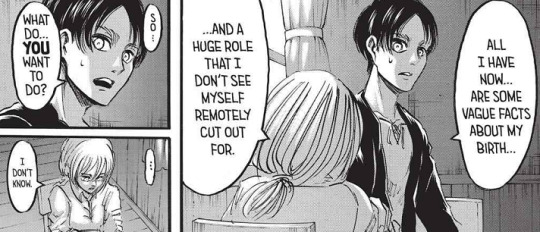
(ch. 54)

(ch. 70)
I can easily see them as partners, which is something I've always had troubles with when it comes to EM. It's just hard not to make this comparison, since Mikasa's character has always been pretty much fully centered around Eren, which - in my eyes - made their relationship look unbalanced and toxic. I've already spoke about my issues with EM in depth in this post, so I won't elongate this one with repeating the same arguments - still, one of the reasons I started shipping Erehisu in the first place is the fact that I immediately saw it as a much more normal, healthy, and well-balanced alternative to EM.
Parallels and relevance to the story’s themes
Parallels are something that, for some reason, make a lot of people mad. I have no idea why - these things appear in the manga, so why not talk about them?
Aside from parallels between Eren and Historia (...please, keep in mind that I didn’t list all of them in this post), there are also a lot of obvious parallels between Historia and the founder Ymir - to the point, when the entire Requiem der Morgenröte ending revolves around this theme:
youtube
I've also already spoke about how Ymir/Historia parallels could possibly be tied to Eren in this answer.

(Historia on the cover of vol. 16/Ymir in ch. 122)
Aside from that, there are a few subtle Grisha/Dina and Eren/Historia parallels, as well. Historia is a royal, hiding as a regular person - just like Dina did, before joining the revivalists. Dina also tears up when Grisha stands up for Eldians, just like Historia does when Eren stands up for her.

(ch. 68)
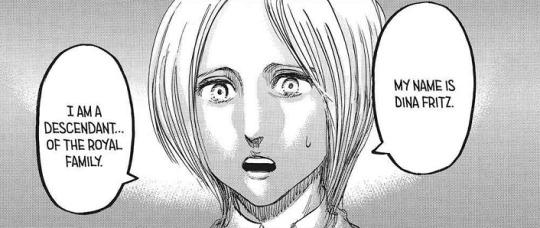
(ch. 86)

(ch. 67)

(ch. 86)
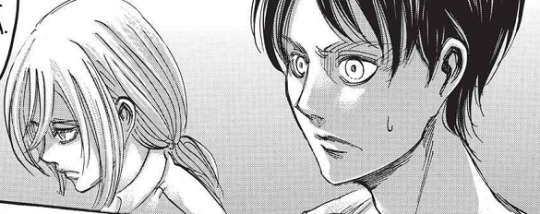
(ch. 56)

(ch. 86)

(ch. 107)
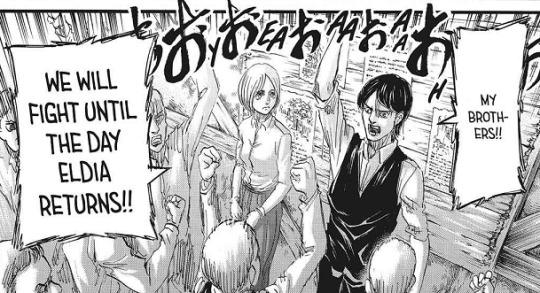

(ch. 86)
Quite interestingly, in a lot of these parallels Historia and Eren act in an opposite way as to previous generations. While Frida teaches Historia to be a good, selfless girl, Historia ends up abandoning this persona to save herself and Eren in the Reiss cave. She doesn’t want to devote herself to fate - instead, she’s prepared for a showdown with it. While the founder Ymir’s children are ordered to eat their own mother to ensure her power’s succession (...and a few hundred years later, Grisha fights to return the founder’s power back to his wife - Dina), Eren does everything he can to ensure Historia and her children are safe and never even titanised in the first place.
As the story unfolds, we learn about it’s leading themes - some of which are: oppression and fighting for freedom, desire to change history, the mechanism of circle of hate, and how it affects children who are a part of it. In my eyes, Erehisu just perfectly fit with these themes, especially considering how later on Historia’s pregnancy was handled in the manga.
There were countless ways to answer the who’s the father question? immediately, without even starting up conversation about it - for example, I don’t understand why it was needed to bring up the fact that Historia didn’t marry the farmer in the first place. What was it’s purpose, aside from stirring up theories - especially considering how in the last chapter it’s revealed that they are married, after all? Why end up the Eren/Historia flashback on the What do you think about me having a child? question, when the whole conversation they had beforehand was literally about Eren disagreeing with Historia wanting to get pregnant just to save herself? It doesn’t make sense, and led me (and many other readers - judging from opinions I read online and chapter reactions on youtube) to belive that there were other reasons, and that there was more to this conversation then was initially shown.
If the conclusion to this plotline was always supposed to be that she got pregnant just to save herself...then what was this mysterious built-up for? Why show this conversation in the first place, and in such a weird manner, too? Why not have Historia just say it out loud in ch. 130: yes, I got pregnant to save myself in the beginning, and spare us this whole I will not allow it talk...you know, instead of ending the conversation on the What do you think about me having a child? when the whole previous talk was about Eren fighting against it? Where’s the logic?
The truth is - from my perspective, Erehisu had a lot of logical build up that would benefit the story, and stay true to it’s already established themes and both characters’ previous developement. On top of that, I also think they simply had great chemistry.
That’s all from me today 😄 I apologize you had to wait so long for this, anon...life got in the way, and as I said - I think I’m just getting over this series. Hope you’re doing well anyway 😊
#erehisu#erekuri#eren x historia#SnK Spoilers#snk shipping#snk rant#anti eremika#aot 139#aot spoilers#attack on titan#snk manga#historia reiss#eren jeager#shingeki no kyojin
253 notes
·
View notes
Text
Signs of Jesus return
i felt lead recently to compile some of the signs and current events pointing to Jesus’ soon return. i don’t know who this is meant for, but i know it’s for someone. so i hope that whoever reads this finds it helpful and informative 💙 (this is not complete either, as there are too many to list)
The Fig Tree Generation:
Jesus often used a fig tree to describe the country of Israel in His prophecies. “Now learn a lesson from the fig tree. When its branches bud and its leaves begin to sprout, you know that summer is near. In the same way, when you see all these things, you can know His return is near, right at the door. I tell you the truth, this generation will not pass from the scene until all these things take place.” (Matthew 24:32-34)
In Psalm 90, Moses describes a generation being “70-80 years,' and Isaiah 66:7-8 says, “Before the birth pains even begin, Jerusalem gives birth to a son. Who has ever seen anything as strange as this? Who ever heard of such a thing? Has a nation ever been born in a single day? Has a country ever come forth in a mere moment?” This did happen. In 1948, Israel became a nation in a day, after almost 2000 years. Israel needed to be a nation to fulfill its part in the Tribulation, so the countdown couldn't start without them. The imagery of birth pains is used in the Bible to describe the troubles that the world will go through before the Day of the Lord, meaning Israel must become a nation before the Lord's return.
1948+80 year generation= 2028. But since Jesus said “everything” (Rapture and Tribulation) would happen before the fig tree generation passed away (turns 81), we have to take away 7 years from the 2028 final count. That leads us to 2021-May 2022 approximately (right before they turn 74).
The Jewish Temple:
The book of Daniel speaks of the time during the 7 year Tribulation, when the Antichrist will come and take over Israel. “The ruler will make a treaty with the people for a period of one set of seven, but after half this time, he will put an end to the (daily) sacrifices and offerings. And as a climax to all his terrible deeds, he will set up a sacrilegious object that causes desecration, until the fate decreed for this defiler is finally poured out on him.” (Daniel 9:27) “The day is coming when you will see what Daniel the prophet spoke about- the sacrilegious object that causes desecration standing in the Holy Place.” (Matthew 24:15)
The second Jewish Temple was destroyed in 70 A.D., and hasn't been rebuilt since. The Holy Place is a specific spot inside the Temple, and the daily sacrifices and offerings that go along with the Jewish Law are only performed with the Temple in use.
As of 2021, the preparations for the Third Temple are nearly complete. The plans are laid out, the priests have been trained in the rules and rituals, the materials are all gathered. One source even says that theoretically the Temple could be built in a matter of 3-6 months. All they are waiting for is the go ahead. Those of the Jewish faith don't believe that Jesus is their Messiah, and many expect that the building of Third Temple will coincide with their own messiah making his appearance.. It's noteworthy that they're so close to building it after all this time.
The Abraham Accords:
In September 2020 the Abraham Accords were officially signed, setting up a peace deal with multiple Middle Eastern countries, including the United States. Since then other countries have added themselves to the peace treaty. There hasn't been a deal like this in the Middle East in a long time, much less centered around Israel. When the Antichrist comes to power, he strengthens a treaty or proposal of peace that already exists, and so the Abraham Accords have come at a significant time.
“Nation will go to war against nation, and kingdom (ethnicity) against kingdom. There will be great earthquakes, and there will be famines and plagues in many lands, and there will be terrifying things and great miraculous signs from heaven.” (Luke 10-11)
Wars:
So many of the great wars in history have been within the last hundred years. War is not an uncommon thing for humanity, but the impact is much greater now, as is the frequency of wars on the horizon. Currently, many of the World Powers are already declaring war and/or making preparations. China threatening war against Taiwan and it's allies, Iran desiring to destroy the US and wipe Israel out as a nation, and many more threatened. It's not a question of if but of when.
Earthquakes:
The frequency of earthquakes has drastically gone up over the last couple years, not only in numbers but also in magnitude power. As I'm writing this (8/22/2021), we've had over twelve 7.0+ earthquakes in the last two weeks. That's not a normal level, not even taking into account all the earthquakes of lower magnitudes. Volcanic activity is rising as well. Many volcanoes that were previously thought to be dormant are awakening, some even erupting. Iceland's volcano Fagradalsfjall was thought to be dormant for 6000 years, until it erupted last March. (“Dutchsinse” on Youtube is a good source for seismic activity.)
Famines:
Because of the change in weather patterns, with flooding and wildfires and droughts, many of the worlds “bread baskets” (where a large portion of their food is grown) are not producing enough food. A shortage is already coming on America, not to mention all the other nations that are in the midst of one. Greece, Turkey, Australia, Italy, California and Oregon (US) are all burning at record rates. And mass flooding is impacting just as much area, like Indonesia, China, New York (US), Haiti, Germany, and more.
Plagues/ Diseases:
Everyone is aware of the effect of the C Virus on the world, and now a new variant is appearing. Diseases like Ebola and the Bubonic Plague are re-emerging. Animals are experiencing these effects as well. Massive animal die offs are happening all over the world, from mysterious diseases and unknown causes. Various plagues have swarmed countries, for instance the mass attacks of locusts that have eaten through parts of Africa, and the infestation of billions of mice in Australia.
Signs in the Heavens:
“And I will cause wonders in the heavens and on the earth- blood and fire and columns of smoke. The sun will become dark, and the moon will turn blood red before that great and terrible day of the Lord arrives.” (Joel 2:30-31)
As I mentioned earlier, volcanoes all over the world are waking up and erupting at an alarming rate. The super volcano centered in Yellowstone Wyoming (US) has been showing worrying signs of stirring as well.
In 2014, two Blood Moons landed on two of God's Feasts, which carry significance. Then in 2015 there was a Solar Eclipse, followed by another two Blood Moons that landed on the same Feasts as the previous year. In 2017, the Great American Solar Eclipse drew a line across the US. In 2020, the “Bethlehem Star” made an appearance as Jupiter and Saturn almost merged in the sky. Though it's not the same cosmic event as the true “Star” that heralded Christ's birth, its rarity and symbolism is important. This August 2021 we just had a rare Blue Moon.
The Revelation 12 Sign:
“Then I witnessed in heaven an event of great significance. I saw a woman clothed with the sun, with the moon beneath her feet, and a crown of twelve stars on her head. She was pregnant, and she cried out because of her labor pains and the agony of giving birth.” (Revelation 12:1-2)
In September 2017, this sign appeared in the sky for the first time ever. The constellation Virgo represents the woman, and the nine stars of Leo plus 3 wandering stars lined up as her crown. The moon was near her feet in the constellation and the sun was at her shoulder shining on her “clothes.” Then Jupiter entered the middle of the constellation (her stomach) and stayed there for nine months and left. Jupiter is generally considered to represent a ruler, and the child in Revelation is believed to represent the Church (Jesus' Body). The rest of Revelation 12: 3-5 speaks of the child being snatched away from the Dragon (the devil), which represents the Rapture of the Church before the Tribulation. So it's incredibly significant that the first part of this prophecy was fulfilled in the stars.
(There's also a type of 4 year grace period before judgment in scripture (Luke 13:6-9), so 2017+ 4 years warning = 2021).
The Vaxx System:
“He required everyone- small and great, rich and poor, free and slave- to be given a mark on the right hand or on the forehead. And no one could buy or sell anything without that mark, which was either the name of the beast or the number representing the name.” (Revelation 13:16-17)
This is not about whether or not to take the vaxx, it's about the mentality around it. The animosity in the world media keeps growing towards those who don't wish to take it. The results don't add up to how single minded they are becoming, and it's easily paving the way for regulations to be carried out by brute force. There are stricter and stricter limitations to those who don't feel safe taking it, like being unable to shop at a grocery story or go to work... In the future, the world won't blink twice about a universal Mark of much greater magnitude and greater consequences. The consequences of refusing won't just mean an inability to buy or sell, but death.
Alien Disclosure:
As of 2021, the US government has released the information they have on Unidentified Flying Objects, confirming the possibility of aliens. The first main stream event involving the alien conspiracy was the Roswell Incident of 1947, about a year before Israel became a nation. The reason why this is so significant is because 1) the Fig Tree prophecy was about to start when Israel revived, beginning the End Times countdown and 2) 2 Thessalonians 2:11 says the people left after the Rapture will believe a “Great Delusion.” Even a couple years ago, the thought of aliens coming down and taking people away would have been laughed at, but not now. Satan is the Prince of the Air; he uses his demons and spirits to appear as other things, so as to lead people away from the Truth of God. He knew when Israel became a nation the clock was ticking for the need of a believable lie. Now people could easily believe that all the Christians that disappeared were “beamed up” by aliens. (We don't know specifically what the Delusion will be yet, but this is certainly a possibility.)
Dreams and Visions:
“ 'In the Last Days,' God says, 'I will pour out my Spirit upon all people. Your sons and daughters will prophecy. Your young men will see visions, and your old men will dream dreams. In those days I will pour out My Spirit even on my servants- men and women alike- and they will prophecy.' “ (Acts 2:17-18)
Around the end of 2019 to the beginning of 2020, End Times dreams skyrocketed. The sheer amount that can be found on Youtube is astounding and it continues to grow. Dreams about the Rapture, dreams from Jesus, dreams about disasters that are coming; people from all over the world are sounding the alarm. And these aren't internet celebrities or self proclaimed prophets; these are every day normal people, some of which weren't even Christian to begin with. The amount of non-Believers that have had Jesus appear to them to save them continues to grow as well.
I personally felt an awakening through the Holy Spirit sometime around early 2020, that Jesus was returning soon. And the more I've studied Bible prophecies and current events I know that it's fast approaching. Although it's important to test the spirits of dreams to see if it's really from God or not, the message of the majority is clear. Time is short.
(This was just a small selection of the MANY signs that God continues to send as warnings. The frequency and intensity is rising like it never has before. A more in depth list can be found, along with Bible references and news sources, at https://www.ithasbeenwritten.com/ )
To You:
For those of you who are un-Believers, I am not writing this to be a fear monger. When evidence and reports come in that there's a bomb in a building, the people inside need to know about it. Even if it ends up being fake, the risk isn't worth it. This isn't just one fanatic Christian with a dream trying to convince everyone the end is near, this is the whole world. No matter what you believe about Bible prophecies, these current events are real things that are happening, and show no signs of slowing down. The good news is that Jesus died to save you from all this. He died to clear our sin debt and give us the hope of Heaven, a place we could never get to on our own. And His signs are saying He's coming soon to rescue everyone who accepted His sacrifice and entered His family.
“If you confess with your mouth that Jesus is Lord and believe in your heart that God raised Him from the dead, you will be saved.” (Romans 10:9)
For those Believers that don't think Jesus is returning soon, please pray about it and study His word. He was angry at the Pharisees of the generation of His first coming, because He said, “You know how to interpret the weather signs in the sky, but you don't know the how to interpret the signs of the times!” (Matthew 16:3).
Matthew 24's “no one knows the day/hour” is not saying that we won't know the season in which He will return. If it were, He wouldn't have gone to all the trouble of giving so many signs of the closeness of the event. “So you, too, must keep watch! For you don't know what day your Lord is coming.” (Matthew 24:42) “But you aren't in the dark about these things (signs), dear brothers and sisters, and you won't be surprised when the Day of the Lord comes like a thief.” (1 Thessalonians 5:4) Are you watching? Let's do our best to be a light as much as possible before it's too late.
“So when all these things begin to happen, stand and look up, for your salvation draws near!” (Luke 21:28)
#Christianity#Jesus Christ#faithstuff#bible verse#revelation#salvation#The Rapture#end times#the tribulation
38 notes
·
View notes
Photo

Siren Song.
Undine writer-director Christian Petzold talks to Reyzando Nawara about modern-day mermaids, Tinder culture and finding the magic in life.
“Love stories always change. A kiss in Berlin 1933, for example, is not gonna be the same kiss in Berlin today, right?” —Christian Petzold
“If you leave me, then I’ll have to kill you.” Undine’s threat to her soon-to-be ex-boyfriend Johannes, after he has told her that he has met someone else, seems at first like an over-the-top reaction to the breakup. But it is a curse that Undine must fulfill, for she will become human only when she falls in love with a man who is doomed to die if he is unfaithful to her.
From Splash to Ponyo to The Lure to Song of the Sea, mythical water spirits, usually female, sometimes horse, have powered many film plots. The sixteenth-century European myth of Undine, in particular, lies behind many screen adaptations of Hans Christian Andersen’s The Little Mermaid, though the Danish writer was not the first to popularize the fairytale in his century. Decades earlier, around 1811, Friedrich de la Motte Fouqué of Germany had produced his romantic novella, Undine.
And it is to Germany—specifically modern-day Berlin—that writer-director (and fellow German) Christian Petzold transports Undine in his contemporary magical-realist take on the myth. There, she does not take the form of a mermaid or siren, but a beautiful young woman (played by Paula Beer), who works as a historian at a museum, where she guides tours of Berlin’s architecture and its reconstruction. The breathtaking cinematography, by regular Petzold collaborator Hans Fromm, crystallizes both the romance and the beauty of Berlin, while Petzold’s leads root every scene in reality, even as aquariums explode and giant catfish drift past.

Paula Beer and Franz Rogowski fire up the streets of Berlin in ‘Undine’.
Water may be the dominant element in Undine, but Beer and her co-star Franz Rogowski bring fire to their scenes together. Where Beer brings charisma and intensity to the titular role, Rogowski, as Undine’s new love interest, an industrial diver named Christoph, offers charm and sweetness.
In the frenzy of Parasite’s world domination, it is easy to forget that Petzold’s previous feature, Transit, appeared in two of our 2019 Year in Review lists—the 50 highest-rated films and the highest-rated international films—and was one of the top romance films of the 2010s. His riveting Phoenix is still his highest-rated film on the platform—one of many to center a complex female character in search of love at a time of personal and/or political crisis. In Undine, Petzold does it again, a welcome departure from other adaptations, including the Colin Farrell-starring Irish romantic drama Ondine (2009), that have mostly told the myth from the perspective of its male characters. Petzold also revises the fairytale, by giving Undine a chance to try to emancipate herself from her curse.
We recently had the pleasure of speaking with Petzold about his fascination with water, the magic of Berlin history, modern dating and of course, his ongoing collaboration with Beer and Rogowski.
Spoiler warning: this conversation contains plot details regarding the ending of Petzold’s film ‘Transit’ (2018).

Your movie is inspired by the myth of Undine, but you reinvent it by giving it some modern twists. How did the main narrative for the film come about?
Christian Petzold: I think the idea of the story first came to me around twenty years ago when I had a project in Germany. It was together with Claire Denis and also Kathryn Bigelow, and everybody had to make a ten-minute short film for a project based on the museum near the Rhine River. I had written a little dialogue—oh, by the way, Steve McQueen was also part of the project—and it was the scene that we can see in the movie in the first few minutes where Undine’s boyfriend, Johannes, said that he doesn’t love her anymore and that he wants to leave her and she said to him, “If you leave me, then I’ll have to kill you.” Then she goes back to work, and later when she comes back to try to find him again, he isn’t there—so she knows that she has to kill him now.
Then when I made Transit with Paula Beer and Franz Rogowski, I told them after a very lucky and happy time of shooting, that I had written a short story and wanted to make a 90-minute feature movie out of it together with them. I wanted to keep working and making movies with them because we’ve had an amazing experience together in Transit. This was basically the start of how the movie and my collaboration with these two actors came about.
Paula and Franz are actors who didn’t come from the basic German acting school; their backgrounds are dance and theater. But they both have so much curiosity about cinema—when I met Paula for the first time, for example, she told me that she had bought 50 movies by Alfred Hitchcock and wanted to see all of them, and to me, this is the best kind of school to learn about cinema.
So to some extent, Undine is a spiritual sequel to Transit?
Yes, you’re right. It has so many things to do with Transit. Marie, Paula’s character in Transit, finds her own death in the sea—she’s drowned. And Franz’s character, he’s waiting at the land, hoping that she may come back from the land of the dead. So I said to them, “Okay, the next movie is gonna be about a woman coming out of the sea and going to the land to search for love and also about this young man who is a diver, who is going underwater, to find love as well.” So to some degree, it’s a sequel, you’re right.
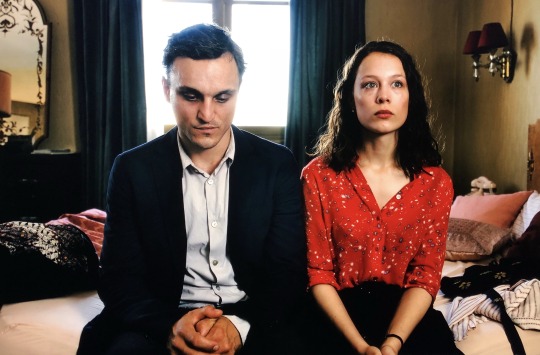
Beer and Ragowski in ‘Transit’ (2018).
You mentioned earlier that you had a great experience working with Paula and Franz in Transit. Can you tell us what it was about these two actors that you thought would capture the story you wanted to tell in Undine?
Paula is a very young actor—she was 23 when we started Transit, and she was around 24 when we made Undine—but when you’re filming her, she has this ability to make her characters much more mature beyond her real age. In one second, she’s 45 years old, with a whole experience of someone who’s had a hard life and has gone through so many bad things, then one second later, she’s thirteen and innocent. And to have that kind of ability—to go from one point to another—is just really fascinating to me. I’ve never seen other actors do this before in my life.
Franz was a dancer, and if I remember correctly, I think he was also in a clown school for a circus, so he can do everything with his body. It’s unbelievable what he can do. He has this amazing physicality that I admire and haven’t seen before in other German actors. When they’re together sharing a scene, they dance with each other. And this is the thing that I like so much about them and the thing I need in Undine, because I need actors who can float from one scene to another as if they’re dancing underwater.
In literature and pop culture, the myth of Undine has been mostly told from the male perspective. You reframe the narrative, to give Undine the opportunity to maybe emancipate herself from both the male figure in her life and the curse. Tell me more about that choice.
Two or three years ago, I had a retrospective in New York, and I had the chance to see some of my previous movies again—[laughing] I’ve actually never done it before, revisiting my own movies. And at that time, I realized that I’ve always tried to rewrite the stories centering on women, which were made by men in the ’40s, ’50s, ’60s and ’70s, from another perspective: the perspective of the women.
When I was in Venice for the first time, Claude Chabrol [was] in the same hotel as me, and he had a Q&A. I wanted to say hi and tell him how great he was but I couldn’t do it because I was very young and too shy for those things. I heard what he said when asked why in his movies, the women are always the main characters. His answer was, “Men are living, women are surviving. And cinema is about surviving.” It was such a fantastic answer.
All the movies I [have] made, including Undine, are about surviving. Undine wanted to survive her curse—she tries to, every time, since centuries ago. In so many iterations of the myth, Undine always has to go back into the lake and to the life the curse has set for her. I really wanted to zoom in on that, to liberate the character of Undine from the myth and the curse.
In the movie, Undine works as an historian at a museum, and in her tours, she talks about Berlin’s architecture and its reconstruction throughout the years. How is this related to the romantic aspect of the movie?
Everybody says you can take a love story and put it in the sixteenth century or the nineteenth century, and it’s always gonna be the same kind of love story. But I think that’s not entirely right. Love stories always change. A kiss in Berlin 1933, for example, is not gonna be the same kiss in Berlin today, right? Therefore I want to take the historical aspect of Berlin architecture and its reconstruction to tell the story of two young people in Berlin nowadays, to see the evolution of both this love story and the myth of Undine itself.

What’s the significance of all the buildings Undine mentions in the movie?
The buildings serve a very important role in the movie because Berlin is between two rivers on an island, and the city is built on dried-out swamps, so the element that Undine is coming from, which is the water, is destroyed in Berlin. It doesn’t exist anymore. And therefore Undine doesn’t have any habitats, so she has no choice but to adapt and to live on the land.
In some way, I always think that the modernization in Berlin erases history, and when there’s no history, there’s no magic, which means magical creatures like Undine won’t exist. That was the main idea of the architectural elements in the movie.
Is that also the reason why there are two locations in the movie: Berlin, and the small town where Franz’s character, Christoph, works and lives, which is still full of swamps? To show that in this small town, magic still exists?
That’s a good question. The romance and the myth of Undine is a part of German and European history. It’s a unique enchantment. But in Berlin, where modernization and civilization keep growing and changing, there’s no enchantment anymore. So I want to show how in this small town where everything is still kept as closely natural as possible, the enchantment and the charm of Germany are still there.
There’s a beautiful and romantic poem by Joseph Eichendorff that says, “You must find the right world, so everything can sync again.” To me, that line encourages us to find the magic of the world back. We live in this world surrounded by retro buildings and retro behavior and retro music, but it’s all actually just an illusion of magic. The real magic, that’s something that we have to find—either by movies or camera positions or poems or even by preserving the naturality of a city. And the Undine myth actually has a lot to do with this.
Another thing that fascinates me about the movie is how the dynamic between Undine and Johannes, in some way, reflects the state of modern dating. Is this something that you also wanted to capture when you wrote the script?
[Laughing] Funny story, when Paula read the script for the first time, she told me that she liked it so much because the story reminded her of Tinder and modern dating. And on some level, it’s true; part of Undine is about modern dating. I always think that in the era of dating apps, everything gets much simpler—you meet someone, you have sex (or perhaps not), and if you feel like this someone is not handsome or beautiful enough for you, you can keep scrolling until you find someone new. So, dating right now is like going to the supermarket.
Johannes leaving Undine to be with another woman, who for him is better-looking than Undine, reflects the culture of Tinder. And the line I mentioned earlier, “If you leave me, then I’ll have to kill you,” is the opposite of that kind of dating life. And Paula, who hates Tinder, loves that line a lot. Some of the actors are on Tinder, I’m sure, and that’s understandable. Actors are sometimes very lonely because for six to eight weeks, they are deep inside of a character, and when they’re on break, they’re in some sort of “black hole of loneliness”.
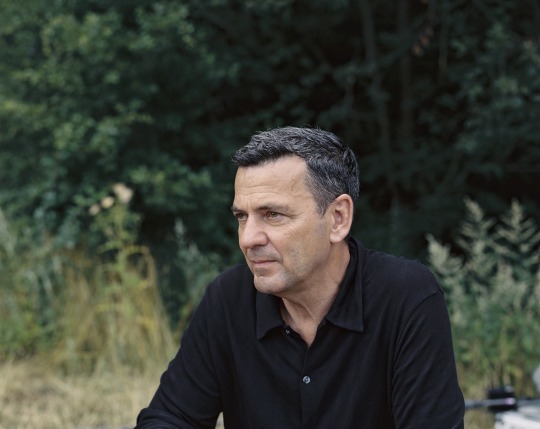
Writer-director Christian Petzold.
Undine being a water nymph, of course, makes the water element very important in this movie. But water has actually been heavily featured in some of your previous features as well, like in Yella, Barbara and Transit. Can you tell us why you find water fascinating?
I’ve seen a documentary by Agnès Varda, and in [it] she said, “The place where one element is touching one another is the place where cinema builds its stories.” That’s why she loved the beach, because on the beach, there’s water and there’s the earth and there’s also wind, and they’re touching each other. So to her, the beach is the perfect place where you can tell a story.
For me, however, the reason I like featuring water or the other elements in most of my movies is because it has something to do with seeing my characters coming from one element then going to the other elements; to see them act and react in a new and sometimes uncomfortable place. Also, when you see pictures or paintings, so many of them are about people looking deep into the sea. I always feel like that kind of painting is actually about a desire. And most of my movies, at [their] core, are about desire. That’s why water is so important to me. Deep under the water, there’s the place of desire.
What’s the first movie that made you want to become a filmmaker?
The first movie I loved very much as a kid was The Jungle Book, but the first movie that made me want to become a filmmaker was by Alfred Hitchcock, The 39 Steps. I was fourteen or fifteen years old when I saw the movie for the first time, and I loved it from the first moment. The movie is about a man and a woman who are bound by handcuffs, and they don’t like each other, but because they’re on the run, they have to communicate and come to an understanding. And the love story starts because of that communication, not because of looks, and I love the movie so much for that reason.
If you could program a double feature with Undine, what movie would you pick?
Good question. I would say The Night of the Hunter. Also maybe Creature from the Black Lagoon or 20,000 Leagues Under the Sea or The Son’s Room by Nanni Moretti. These are the movies that I would recommend for a double feature with Undine.
Related content
More ‘Little Mermaid’ adaptations: a list by Katherine
Paula Beer strolling around towns cinematic universe
Diogo’s mega-list of Mermaids in Film
Horror’s History with Scary Mermaids: a Bloody Disgusting list
Follow Reyzando on Letterboxd
‘Undine’ is in theaters and available on VOD in the US now.
#christian petzold#paula beer#transit film#undine#undine myth#ondine#water nymph#mermaids#mermaid film#german film#german director#german screenwriter#german cinema#cinema germany#romance#romance films#Reyzando Nawara#franz rogowski#letterboxd#filmmaker#letterboxd interview
24 notes
·
View notes